In cooperation with Björn, it is splitted on "Disease is Different" into the sections by organ systems and combined with the real cases of our international testimonial / report archive of the related organ system.
EYE
Vitreous body
Fear-of-Rear-Attack Conflict
Eyelid, epidermis
Visual-Separation
Conflict
Eyelid, dermis
Visual-Disfigurement Conflict
Cornea
Visual-Separation
Conflict
Retina
Fear-of-Rear-Attack
Conflict

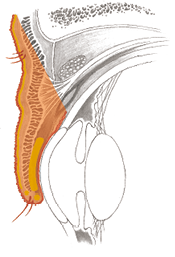
Conjunctiva
Visual-Separation Conflict
Eyelid, subcutis, fatty tissue
Aesthetic-Self-esteem Conflict
Conjunctiva
Visual-Separation Conflict
Choroid
Visual-Chunk Conflict
Iris, ciliary muscle
Chunk (Motor) Conflict
Lens
Visual-Separation
Conflict
Inflammation of the eyelid (blepharitis), pink eye (conjunctivitis)1
MC (molluscum contagiosum)
Same SBS as above. MC causes wart-like growths on upper and inner lid of the eye with a central dipping.
| Phase | Repair phase – Persistent repair of the upper lid caused by a visual-separation conflict. Excessive repair > growth of warts. |
|---|---|
| Therapy | Questions: see above. Determine the conflict and resolve it in real life, if possible, so that no new growths appear. Guiding principle: “I am bound to all of the people that I like. An invisible band binds us, even when we are not together.“ Surgical removal, if the warts are mechanically or aesthetically disturbing. |
Pterygium
Same SBS as above (see: p.102). A pterygium is a growth on the conjunctiva that spreads from the edge toward the pupil and can restrict vision.
| Phase | Persistent repair of the conjunctiva |
|---|---|
| Therapy | Questions: see: p.103. Find conflicts and triggers, OP (outpatient) if the visual field is disturbed. Nevertheless, work on conflict resolution, otherwise it can grow back. |
Pinguecula
Same SBS as above (see: p.102). Yellowish colored thickening of the conjunctiva on the inner or outer corner of the eye (lid division).
| Phase | Persistent repair of the conjunctiva |
|---|---|
| Therapy | Questions: see: p.103. Also in CM, OP is seldom considered because patches only interfere mostly aesthetically. |
1 See Dr. Hamer, Charts pp. 119, 132
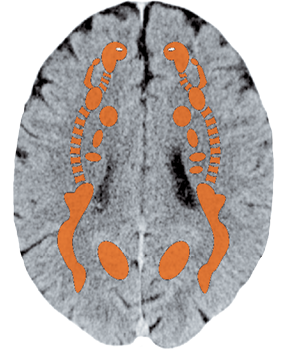
Wart-like fatty deposits on the eyelid (xanthelasma)
| Conflict | Self-esteem conflict regarding the aesthetics of the eye or the face. One doesn’t feel attractive enough. One wrangles with their appearance. See also p. 346. |
|---|---|
| Example | ➜ A woman examines her face in the mirror and notices that she has wrinkles around her eyes. |
| Conflict-active | Unnoticed, local degradation (necrosis) of the fatty tissue. |
| Repair phase | Persistent repair: Reconstruction, i.e., building up fatty tissue. As with bones, the same happens with fatty tissue: Repair is generous and additional material is added (luxury group). Development of xanthelasma. |
| Bio. function | Increase in the fat covering. In the eyes of Mother Nature, “being fat is good and attractive.“ An animal that succeeds in adding fat is successful and desirable. An animal gets thin on its own when it becomes old and weak. |
| Note | Consider “handedness“ (right or left) and side (mother/child or partner) or local conflict. Danger of a vicious circle, because the xanthelasma itself is regarded as disturbing and disfiguring. |
| Questions | When did the xanthelasma appear? What was stressing me at the time? Why don’t I like myself? Why is my appearance so important? How do/did my ancestors think about their appearance? Were they also fixated on their external appearance? (Determine conditioning). What remains of life, the inner life or the body? What comes after death? What counts then? |
| Therapy | Determine the conflict or trigger and resolve it in real life, if possible, so that no new growths appear. Guiding principle: “I am satisfied with my looks and my eyes!“ “The brightness of the soul is more important than my appearance!“ “Milky Way“ therapy. Bach flowers (see p. 59): larch, crab apple. Surgical removal as necessary. |
Lacrimal glands
Visual-Chunk Conflict
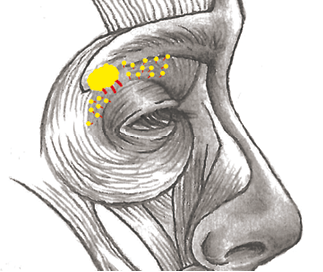
Lacrimal glands – excretory ducts
Visual-Recognition
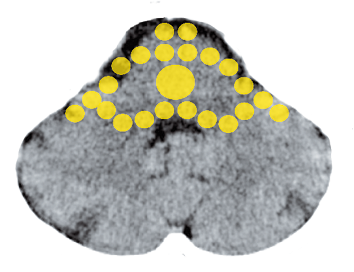
Watery eyes (epiphora), Lacrimal gland tumor, lacrimal gland inflammation (dacryoadenitis)1
Each eye has one lacrimal gland, about the size of a hazelnut, and 20-30 small (accessory) lacrimal glands. The tear fluids they produce moisten, nourish, and cleanse, the conjunctiva.
| Conflict | Visual-chunk conflict (see explanations p. 15, 16). To be unable to grasp (right eye) or to get rid of something (left eye). Simply: You cannot see something you would like to see or seeing something you don‘t want to see. |
|---|---|
| Examples |  A single, young woman suffers on the one hand, because she must regularly visit her aging parents, and on the other hand, an old friend at the same time – chunk conflict of wanting to get rid of the old friend (something uncomfortable) > cell division in the left lacrimal gland > weeping left eye. (See Claudio Trupiano, thanks to Dr. Hamer, p. 291) A single, young woman suffers on the one hand, because she must regularly visit her aging parents, and on the other hand, an old friend at the same time – chunk conflict of wanting to get rid of the old friend (something uncomfortable) > cell division in the left lacrimal gland > weeping left eye. (See Claudio Trupiano, thanks to Dr. Hamer, p. 291) A woman commutes to work on her bicycle. For the last 10 years her left eye always starts to water for about 10 minutes after she passes a certain location. Cause: 10 years before, her son, who was 7 at the time, had a bad bicycle accident at that very location. As “therapy” the woman assures herself that the situation is over and everything has turned out well. Since then, her eye doesn’t water anymore. (Archive B. Eybl) A woman commutes to work on her bicycle. For the last 10 years her left eye always starts to water for about 10 minutes after she passes a certain location. Cause: 10 years before, her son, who was 7 at the time, had a bad bicycle accident at that very location. As “therapy” the woman assures herself that the situation is over and everything has turned out well. Since then, her eye doesn’t water anymore. (Archive B. Eybl) |
| Conflict-active | Growth of a cauliflower-like tumor (adeno-ca) of secretory quality on the lacrimal glands. |
| Bio. function | With more tear fluid, the sight impression can be better salivated and better ingested (or gotten rid of). |
| Repair phase | Inflammation of the lacrimal glands, tubercular-necrotic caseation of the tumor, purulent tears, pain, and possibly mild fever, night sweats. |
| Questions | What stressed me before the inflammation appeared? Which conditioning allows me to feel this way? |
| Therapy | By inflammation: the conflict is resolved. Support the repair phase and avoid relapse. Apply cold compresses and curd packs. Lymph drainage massages (see p. 68). MMS (see p. 68). Possibly antibiotics or surgical removal as necessary. |
Drying up of the tear fluid (“cystic fibrosis” of the lacrimal glands, xerophthalmia, Sjögren syndrome, dry eye syndrome (DES))
Same SBS as above. For other causes of dry eyes, see: p.107.
| Phase | Recurring-conflict – persistent repair. More and more glandular tissue breaks down and is replaced by inferior scar tissue > a drying up of the tear (lacrimal) fluids > dry eyes. |
|---|---|
| Therapy | Determine the conflict and conditioning and, if possible, resolve them in real life so that the remaining glandular function is preserved or the lacrimal glands can regenerate. Eye baths with eyebright, black cohosh (Actaea racemosa) and horsetail. Lymph drainage massage (see p. 68) to stimulate fluid production. |
1 See Dr. Hamer, Charts, pp. 18, 33
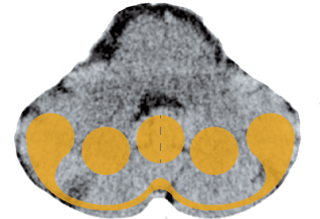
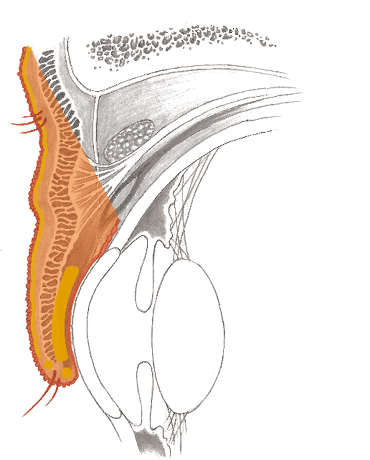
Sebaceous & sweat glands
Visual–Disfigurement Conflict,
Conflict: Fear that the Eye Will Dry Out
Styes (hordeolum) and chalazion
In the upper and lower eyelids, next to the eyelashes, lie the sebaceous glands: the so-called glands of Moll (which service the eyelids), the glands of Zeis (which are sweat glands), and the Meibomian glands (which prevent tears from drying up). An oily film prevents tear fluids from passing the edge of the lid. (The oil repels the watery tear fluid.)
| Conflict | Visual-disfigurement conflict. Damaged integrity of the eye or conflict that the eye is drying out. |
|---|---|
| Examples | ➜ A child sees the constant quarrelling of his parents – visual–disfigurement. ➜ A construction worker is hit in the eye by a metal splinter. ➜ Verbal attack with regard to appearance or the eye.  A city girl sees a mouse torn to pieces by a cat – visual–disfigurement. During the repair phase, the girl suffers from a stye. (Archive B. Eybl) A city girl sees a mouse torn to pieces by a cat – visual–disfigurement. During the repair phase, the girl suffers from a stye. (Archive B. Eybl) |
| Conflict-active | Thickening of the outer layer of the eyelid and enlargement of the Moll, Zeis or Meibomian glands (sebaceous gland cancer). Increased production of sebum. |
| Bio. function | Thickening of the corium/dermis of the eyelid leads to better protection of the eye. With more sebum, the eye can be better oiled. |
| Repair phase | Inflamed-tubercular-caseating degradation via fungi and bacteria, pain = stye. Recurring-conflict: Inflammation with inclusions of connective tissue (granulating inflammation) – chalazion. |
| Note | Consider “handedness” (right or left) and side (mother/child or partner). |
| Questions | Which sight was intolerable to me? (Determine the situation). Why can’t I deal with it? Which event from my childhood does the situation remind me of? What brought me into the repair phase? |
| Therapy | The conflict is resolved. Accompany the repair phase and avoid relapse. If it is recurring, resolve the conflict and conditioning. Cold compresses. If acute: MMS (see p. 68), colloidal silver internally and instill in the eye externally. Bach flowers (see p. 59): if chronic, crab apple. Cayce: if chronic, hot castor oil packs. Compresses and possibly eye baths with eyebright, chamomile, and horsetail. Smear with honey. Lymph drainage massages (see p. 68). Schuessler Cell Salts: No. 3, 9, 11. |
Dry eyes
Most often caused by a “modern“ lifestyle, sometimes by conflicts:
The paper-thin film of tear fluid consists of three components: A layer of mucus at the bottom, an aqueous layer in the middle and a layer of oil at the top.
• Meibomian glands: They produce the oil layer and play the leading role when it comes to dry eyes. The oil prevents the evaporation of the water layer and forms a perfectly smooth surface for the refraction of light. Meibomian gland dysfunction (MGD) is the most common cause of dry eyes. The decline in glandular function is likely a part of the normal aging process. It is also possible that a persistent conflict is involved (see: p.105) > thickening of the oil or blockage of the glandular ducts > loss of glandular tissue. Therapy: Warming the eyelids (warm water) to liquefy the thickened oil again – followed by careful glandular squeezing with the fingers – then cleaning of the eyelid edges with cosmetic tissue/cotton swabs to remove any greasy crust. > dry eyes (p. 106).
• Side effects of medication: In particular, blood pressure medications, “the pill“ (birth control), diuretics, anti-depressants, vasoconstrictive eye drops, etc.
• Age-related estrogen deficiency: One of the signs of aging is increased dehydration of the body due to a drop in hormone levels (especially estrogen). The mucous membranes are affected.
• Working on the computer and watching television cause a decreased rate of blinking > dry eyes for lack of moistening.
• General sympathicotonia or deprivation of sleep, see: p.13 > dry eyes (moist eyes in vagotonia).
• Not enough of the “charms of nature“: light, water, wind, etc.
• Lack of physical movement: reducing the general metabolic rate, including the tear apparatus.
• Conjunctiva in conflict-active phase: feeling of dry eyes (p. 102).
• Lacrimal glands in persistent repair (p. 105).
Tear sacs, swollen eyelids, dark circles
Possible causes:
• Unhealthy, stressful lifestyle: Lack of sleep, alcohol and nicotine abuse, lack of vital substances (nutrition).
• Under (hypo) or over (hyper) functioning of the thyroid gland: SBS of the basic tissue (p. 145) or of the excretory ducts (p. 147): Doughy skin especially on eyelids, hands and feet = myxoedema. > On the basis of the symptoms, blood values, ultrasound, clarify whether an SBS of the thyroid gland is running. > Conflict resolution, thyroid measures.
• Active kidney collecting tubules: Water retention tendency (p. 277).
• Circles under the eyes can indicate liver (lack of detoxification), prostate, bladder or anemia.
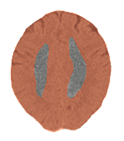
Inflammation of the lacrimal gland excretory ducts1
The main lacrimal gland‘s 10 -12 excretory ducts lead into the eyes from the upper sides.
| Conflict | According to Dr. Hamer: Wanting to be seen or to not be seen. According to Roberto Barnai: Separation conflict, not wanting to see someone or something anymore. |
|---|---|
| Example |  A woman suffers under her intrusive mother-in-law. She is constantly interfering in her life. = conflict, she doesn’t want to see her mother-in-law anymore. When she gets the matter off her chest, by speaking to her husband about it, she experiences inflammation of the lacrimal glands (tear ducts). (Archive Roberto Barnai). A woman suffers under her intrusive mother-in-law. She is constantly interfering in her life. = conflict, she doesn’t want to see her mother-in-law anymore. When she gets the matter off her chest, by speaking to her husband about it, she experiences inflammation of the lacrimal glands (tear ducts). (Archive Roberto Barnai). |
| Conflict-active | Cell disintegration (ulcer), painful tension in the tear ducts > channel widening. |
| Bio. function | Better through flow of the tear fluid due to larger diameter > better sight. |
| Repair phase | Restoration of cell loss. Inflammation, possibly swelling of the ducts, with accompanying blockage of tear fluid > can give the impression of a lacrimal gland infection. |
| Note | Consider “handedness“ (right or left) and side (mother/child or partner) or local conflict. |
| Therapy | The conflict is resolved. Accompany the repair phase and avoid relapse. MMS (see p. 68). Cold compresses, curd and flaxseed packs, lymph drainage massages (see p. 68). |
1 See Dr. Hamer, Charts, pp. 123, 136
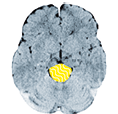
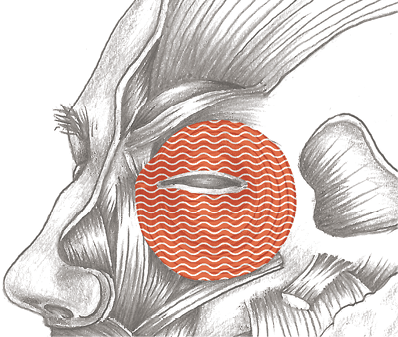
Eyelid-opening m.
Not being allowed to, not being able to, or not wanting to, hold the eyes open
Eyelid-closing m.
Not being allowed to, not being able to, or not wanting to close the eyes
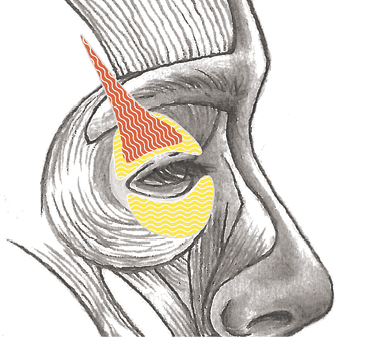
Because of their vulnerability and importance, the eye is protected with two shielding systems: the inner shield is the iris musculature and the outer shield is composed of the upper and lower eyelids.
• According to CM, the voluntary (striated) eye-closing muscle (orbicularis oculi) is responsible for closing the eyes. Unconscious closing of the eyes (blinking) functions through a special nerve connection to the brainstem.
• Two muscles are responsible for opening the eyes. According to CM, the superior and inferior tarsal muscles are involuntary muscles, which unconsciously open the eye when we blink. The voluntary muscles, levator palpebrae superior and inferior, allow us to deliberately or consciously open our eyes or hold them open.
Inverted eyelid (entropion, trichiasis)
The task of the eye closing muscle (orbicularis oculi) is to close the eyelids. When this muscle is under increased tension, the eyelashes can turn inward and rub painfully against the connective tissue (entropion).
| Conflict | Not being allowed to, not being able to or not wanting to close the eyes. |
|---|---|
| Examples |  A nearly 80-year-old, former entrepreneur, must earn extra money by working as a night watchman despite his age. His duty usually lasts the entire night – conflict of not being able to close one‘s eyes. When he comes home in the morning, his eyes drop closed from tiredness and he sleeps for a few hours. In the last 5 years of his career as a night watchman, an entropion has developed. The lower lids of both eyes have inverted, so that the eyelashes rub painfully on the connective tissue, which then becomes inflamed. When he reaches the age of 80, the patient really retires and can sleep every morning as long as he wants. The tension of the lids relaxes and the entropion retreats without a trace. (Archive B. Eybl) A nearly 80-year-old, former entrepreneur, must earn extra money by working as a night watchman despite his age. His duty usually lasts the entire night – conflict of not being able to close one‘s eyes. When he comes home in the morning, his eyes drop closed from tiredness and he sleeps for a few hours. In the last 5 years of his career as a night watchman, an entropion has developed. The lower lids of both eyes have inverted, so that the eyelashes rub painfully on the connective tissue, which then becomes inflamed. When he reaches the age of 80, the patient really retires and can sleep every morning as long as he wants. The tension of the lids relaxes and the entropion retreats without a trace. (Archive B. Eybl)➜ A long-distance driver must drive every night. ➜ A welder is distracted and looks into the glaring light. Tissue/Phase Eyelid-closing muscle (orbicularis oculi) – voluntary (striated) muscle – following completed repair or during persistent repair > increase of tension > eyelashes invert. |
| Questions | When did the symptoms arise? (Conflict must have happened before this). Worsening or getting better? (Getting better > conflict situation is getting better; getting worse > conflict situation is getting worse). Better or worse sleep in general? Sufficient sleep? Which situations cause stress? Is it better on vacation? (If yes, the conflict lies somewhere in daily life). Which conditioning pushes me to it? |
| Therapy | Determine the conflict and conditioning and, if possible, resolve them in real life. Find out where the love is – there you’ll find the solution. Guiding principles: “There‘s no harm in a little nap.“ “When I‘m tired, I just lie down and close my eyes.“ According to Richard Wilford: Dissolve saffron in milk and make an eye compress. Compress of tea made from horsetail, comfrey, chicory, or pot marigold (calendula). CM – OP if the conflict resolution fails and gentle measures do not help. |
Outward-turned eyelid (ectropium)
Diminished tension in the eye-closing muscle leads to a limp, outward hanging lid (ectropium). This leads to weeping eyes because the tear fluids can no longer drain.
| Conflict | Not being allowed to, not being able to, or not wanting to close the eyes. (For examples, see above). |
|---|---|
| Phase | Conflict-active phase: Muscle degeneration and paralysis > the eyelid falls limp toward the outside. Possibly incomplete closure (lagophthalmus) of the eye due to paralysis of the orbicularis muscle. |
| Therapy | Determine the conflict and conditioning and, if possible, resolve them in real life. Guiding principles: see above. Hildegard of Bingen: Lay fresh-from-the-morning-dew rose petals on the closed eye. Compresses or eye-baths of tea made from horsetail, eyebright, comfrey, or chicory. CM – OP, if the conflict resolution fails and gentle measures do not help. |
Drooping eyelids (Ptosis)
Affected is the voluntary muscle, levator palpebrae.
| Conflict | Self-esteem conflict of not being able to, not being allowed to, or not wanting to, keep the eye open. To have overlooked something. Not having been wide awake. |
|---|---|
| Example | ➜ A mother tells her child, “Keep your eyes open! Next time, you‘re going to get hit by a car!“ ➜ Somebody has to work at night and they are so tired that they cannot keep their eyes open. Tissue Eyelid lifting muscle, levator palpebrae – voluntary (striated) muscle – cerebral cortex – ectoderm (nerve supply = innervation) and cerebral white matter (nutrition). |
| Conflict-active | Drooping eyelid caused by paralysis or deterioration of the levator palpebrae muscle. |
| Repair phase | Restoration, eyelid tremor in the repair phase crisis. In persistent repair possibly incomplete eye closure. |
| Bio. function | Strengthening the muscles, so that the eye can be held open at decisive moments in the future (luxury group). |
| Note | Consider “handedness“ (right or left) and side (mother/child or partner) or local conflict. The drooping of both eyelids can sometimes be caused by a general reduction in the sympathetic nervous system. In this case, it may not be an eyelid conflict, but, for example, a thyroid hyperfunction (see: p.145). |
| Questions | When did the symptoms begin? (Conflict occurred shortly before this). What have I overlooked or carelessly ignored during this time? Was I reprimanded or can I not forgive myself for something. What has occupied my mind since then? Why do I react sensitively to this kind of stress? Conditioning from the family? Who acts in the same way? |
| Therapy | Determine the conflict and conditioning and, if possible, resolve them in real life. Guiding principles: “I forgive myself for having overlooked something.“ “I only have two eyes.“ “I go to sleep and wake up when it suits me.“ For further measures, see below. |
Jittering eyelid (eyelid tremor)
Possible causes
1. Repair phase crisis of the orbicularis oculi muscle (see inward and outward-turned lids).
2. Repair phase crisis of the levator palpebrae muscle and/or the musculus tarsalis (see above).
| Example |  A 49-year-old, right-handed patient works for a gynecologist. Her working day starts at 7 a.m. and lasts until 10 p.m. Sometimes she has no lunch break because there is so much to do in the office. The patient is suffering from an extreme deficiency of rest and sleep – conflict of not being able to close one‘s eyes. During this period, the eyelid tremor starts up: during quiet moments, the lashes of the right upper lid (partner side) pull together trembling = repair phase crisis. It is the right eye, because her boss is responsible for the shortage of sleep and rest. Since then, this symptom appears again every time the patient gets too little sleep and rest. (Archive B. Eybl) A 49-year-old, right-handed patient works for a gynecologist. Her working day starts at 7 a.m. and lasts until 10 p.m. Sometimes she has no lunch break because there is so much to do in the office. The patient is suffering from an extreme deficiency of rest and sleep – conflict of not being able to close one‘s eyes. During this period, the eyelid tremor starts up: during quiet moments, the lashes of the right upper lid (partner side) pull together trembling = repair phase crisis. It is the right eye, because her boss is responsible for the shortage of sleep and rest. Since then, this symptom appears again every time the patient gets too little sleep and rest. (Archive B. Eybl) |
|---|---|
| Therapy | If the symptoms return, determine the conflict and conditioning and, if possible, resolve them in real life so that the persistent repair comes to an end. Magnesium chloride (MgCl2) foot bath. Rose leaves taken as tea or applied externally as decoction-compress. Internally: Magnesium, calcium, vitamin B complex, Schuessler Cell Salt no. 7. |

Pupillary Constrictor Muscle
Chunk conflict
Too much light
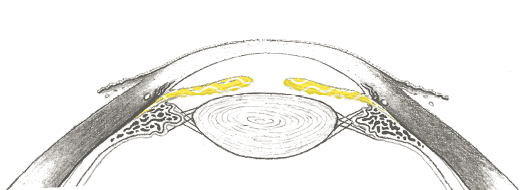
Pupillary Dilator Muscle
Chunk conflict
Too little light
The involuntary muscles of the iris (= “old intestinal muscles”) form the eye‘s inner aperture system.
They regulate the amount of light that reaches the retina. There are two opposing players here: the pupil closing muscle (sphincter pupillae) and the pupil dilating muscle (dilatator pupillae).
The iris sphincter muscle is parasympathically innervated. It becomes tense during rest, thereby narrowing the sight opening. Tired and relaxed people have small pupils. The task of this muscle is to choke off the incoming light when it is too bright.
The iris dilating muscle is sympathetically innervated. It becomes tense when the individual is active. People, who are fully awake, under stress, and/or under the influence of drugs have large pupils. The task of this muscle is to widen the sight opening so that more light falls on the retina when it is dark.
From their tasks we can draw conclusions about their conflict content.
Night blindness, excessive pupil constriction (miosis)
| Conflict | Chunk conflict (see explanations p. 15, 16). Right eye: Too much light. Not getting the chunk because it is too bright. Left eye: Too much light. Not being able to get rid of something one does not want because it is too bright. Not being able to avoid something unpleasant or dangerous because it is too bright. In a figurative sense: You want to hide something from the eyes of others (under the cover of darkness). For some reason you dread the public eye. Not wanting to see the dark side. Fear of dark side in oneself or in other people. |
|---|---|
| Examples | ➜ Too much light due to an actual brightness-shock, such as being blinded by the sun or a welding machine. ➜ A simple laborer falls in love with a rich industrialist‘s daughter but she rejects him because he has too little to offer > not being able to have one‘s dream woman. The right eye is affected. ➜ A man hides that he has served jail time for theft from his employer. He is afraid that he wouldn‘t have a chance with the company otherwise. The matter comes to light nevertheless > too much light on the past. The left eye is affected. |
| Conflict-active | Constriction of the pupil (myosis) due to constant tension in the iris sphincter muscle, possibly night blindness. |
| Bio. function | Narrowing of the pupil, so that less light comes in. Reducing the brightness so that the “chunk“ can be taken better or what one rejects can be better eliminated. |
| Repair phase | Normalization of the pupil size. |
| Repair crisis | Convulsive pupil behavior. |
| Questions | When did the symptoms begin? What do I want to hide/keep secret in my life? Which “dark side(s)” am I not ready to face? Does this tendency lie in the family? Determine the exact conditioning. |
| Therapy | Determine the conflict and conditioning and, if possible, resolve them in real life. |
Over-sensitivity to light, daytime blindness (hemeralopia), excessive widening of the pupils (mydriasis), unevenly shaped pupils
| Conflict | Chunk conflict (see explanations p. 15, 16). Right eye: too little light. Not getting what one covets or wants because of the darkness. Left eye: too little light. Not being able to get rid of what one does not want because it is too dark, or not being able to prevent something unpleasant or dangerous because it is too dark. Frequently figuratively: Cannot put himself in the right light. One gets too little attention. Cannot see or find the spiritual, brightness and luminosity. |
|---|---|
| Example | ➜ At the job center, a hard-working, highly-skilled worker with years of experience must compete for a job with an unskilled worker – conflict that too little light will be shed on his good qualifications. |
| Conflict-active | Constant tension of the pupil-widening muscle > pupil widening (mydriasis). Over-sensitivity to light > light shyness, daytime blindness, the pupils possibly become unevenly shaped. |
| Bio. function | Widening of the pupil, so that more light comes in. Therefore the “chunk“ can be better received or what one rejects can be better eliminated. |
| Repair phase | Normalization of the pupil size. |
| Repair crisis | Convulsive pupil behavior. |
| Questions | When did the symptoms begin? Were did I not get enough attention? Where did I feel like I was standing on the sidelines? Was I given enough attention as a child? Further conditioning (similar parents, events, etc.)? |
| Therapy | Determine the conflict and conditioning and, if possible, resolve them in real life. |
Weeping eyes (epiphora)
Possible causes
- General vagotonia > increased flow of tears.
- Mechanical irritation, wind, foreign bodies > the body tries to “rinse away“ the foreign body.
- Conjunctiva or cornea in the repair phase (see pp. 102, 114).
- Lacrimal glands in the active-phase due to increased production of tear fluid = dacryorrhea (see: p.105).
- Meibomian glands: After too many conflicts, the sebum remain limited > too thin layer of fat> “overflowing“ of the tear fluid (see: p.106).
- Obicularis oculi – Striated portions in an active-phase: the tears cannot be transported (see above).
- Lacrimal gland excretory ducts in the active-phase. (see: p.107).
Therapy
Depending on the cause: Compresses or eye-baths of tea made from eyebright and yarrow.

Crossed eyes (strabismus)
Strabismus comes in varying forms: inwardly crossed eyes (esotropia), wall-eye
(exotropia) and vertical deviation (hypertropia). One or more of the six extraocular muscles are affected:
• The upper straight muscle (superior rectus) pulls the eye upwards.
• The lower straight muscle (inferior rectus) pulls the eye downwards.
• The inner straight muscle (medial rectus) pulls the eye inwards.
• The outer straight muscle (lateral rectus) pulls the eye outwards.
• The upper diagonal muscle (superior oblique) rolls the eye inwards and lowers it.
• The lower diagonal muscle (inferior oblique) rolls the eye outwards and lifts it.
Extraocular Muscles
Not wanting to see an unbearable situation anymore or not being able to escape someone/thing > Esotropia
Missing someone/thing and “searching” for them/it with the eyes > Exotropia
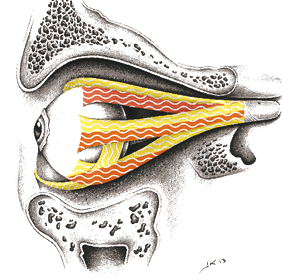
| Examples | • Parents take their 4-year-old son to the zoo and they come to the tiger cage. The path leads through a kind of cave in which the animals are behind bars. At the entrance, the little child suddenly becomes frightened. Thus, the mother takes him in her arms and carries him in – motor-eye muscle-conflict of not wanting to see the tiger. He clutches onto his mother and turns his eyes to the side, so he does not to have to look at the tiger. After the visit to the zoo, the boy is suddenly afraid of the dark. When he watches television, he avoids animal programs. A few days after the zoo visit, the parents notice that the boy often rolls his eyes uncontrollably and has developed a nervous tick (= repair phase – repair phase crisis): he throws his head back and to the left. At the same time, he turns his eyes away. The boy himself finds the tick disturbing, especially when watching television. The parents contact an eye clinic but the symptoms disappear on their own after three weeks. (Archive B. Eybl) ➜ A child‘s parents get a divorce. The baby vainly searches for his mom or dad > outward strabismus or wall-eyes. ➜ A child is taken from his little spot right next to his mother and put to bed in the nursery too soon. He is afraid and searches with his eyes for his mother > strabismus. ➜ A baby has to watch, as he is crying and screaming, while the doctor gives him a shot. ➜ An infant lies in an incubator and must suffer from the glare of an incandescent light. |
|---|
Inwardly crossed-eye(s) (esotropia)
| Conflict | Not wanting to see somebody or an unbearable situation. Not being able to escape a hopeless situation – the escape inwards! Those who are oriented inwards are usually affected here (receptive or introverted types). |
|---|---|
| Example | ➜ A child‘s parents separate. The mother/child eye is fixated for example on the mother – she is still there. The partner eye turns inward “to take the father into himself.“ |
| Phase | Persistent-active conflict of the inner straight or outer straight muscle. |
Outwardly crossed eye(s)/Wall-eye (exotropia)
| Conflict | One misses someone or something and looks for him or it with the affected eye. “The outward search!“ Not being able or wanting to see someone or something. |
|---|---|
| Example | ➜ A child‘s parents argue constantly – “First the parents diverge and then the eyes.“ (Dr. Kwesi Odum). The wandering eye looks for the father in the distance, for example. |
| Note | The affected are usually outward-oriented (leader or extroverted) types. |
| Phase | Persistent-active conflict of the inner straight or outer straight muscles. |
| Note | The outer upright muscle is linked to the SBS of the kidney collecting tubules. (p. 226) > active kidney collecting tubules, for example, of the left kidney > pulling of the left eye outwards = diagnostic clue! The eye can be brought into the correct alignment consciously. (In this case, there is usually not a sight conflict but rather a refugee and existence conflict). |
Vertical deviation (hypertropia), rolling of the eye(s) (zyklotropia)
| Conflict | Not being able, allowed or wanting to see upwards or downwards. Not being able, allowed or wanting to see inwardly down or outwardly up or rolling the eye. In practice: Not being able or wanting to see someone or something located above or below. Fear that something dangerous will come from above or below (hypertropia). |
|---|---|
| Example | ➜ Hypertropia can mean that the child misses it’s mother or father (looking up from below). ➜ While playing, a boy is hit on the head by a tree branch (danger from above) > hypertropia. ➜ A child sees some lying injured on the ground (fear from below) > hypertropia. |
| Phase | Persistent-active conflict of the upper/lower straight muscle or upper/lower diagonal muscle. |
Questions on crossed eyes
As always with children, we have to consider the family system. Children often carry symptoms for their parents. Were there symptoms at the same time that the eyes crossed? (Indication of the conflict’s cause). In what direction does the eye cross? On the mother/child side or the partner side? (Indication of the person involved). When did the crossing happen for the first time? (The conflict must have happened before this). What happened at this time? (You may want to work with your calendar, diary). What affected the child? (E.g., parental quarrelling/divorce, stress with their teacher or in preschool). What was affecting the parents? (Relationship, quarrelling in the family, stress at work). Does the crossing get better during school breaks/vacation? (Then the problem lies in daily life, e.g., school). Is it worse during the day or in the evening? (During the day is an indication that preschool, school is stressful). Evenings is an indication that family, being at home is stressful). Recurring dreams? (Indication of conflict). Ask the child: What would you like the most? (Possible indication of the issue). Who would you like to have here/go away? (Indication of the issue).
Therapy for strabismus
Determine the conflict and conditioning and, if possible, resolve them in real life. Very important: eye training (Books by Leo Angart, Mirsakarim Norbekov. See bibliography.). Spending time in nature instead of in front of the television or cell phone (in nature, the eye follows natural impulses > the eye muscles will be put to use in a healing way). Eye patches or bandages over the eyes only make sense for children and then, only where there is weakness in vision (amblyopia). Patches carry with them the danger of follow-up conflicts due to disfigurement and sight hindrance (it is better if they are only worn at home). An OP should be evaluated very critically, for instance, in order to prevent amblyopia.
Nystagmus (dancing eyes)
With nystagmus, the eyeball twitches involuntarily outwardly or inwardly (most common), away from its correct position. Sometimes upward or downward twitching is possible as well. Sometimes the nystagmus happens in combination with eye crossing – not surprisingly, since both symptoms represent different phases of the extraocular muscles’ SBS.
| Conflict | For a nystagmus on a horizontal plane: Unable to see a danger from the side. Something from the side causing fear – I have to at least control it out of the corner of my eye. See also the conflict descriptions for crossed eyes. |
|---|---|
| Phase | Repair phase, persistent repair of the/an outer eye muscle(s). |
| Bio. function | Whatever is scaring someone should always be kept in sight. |
| Note | When someone has crossed eyes, after the conflict is resolved, nystagmus may appear – a good sign. However, when nystagmus lasts longer than three months, this means that the conflict is persistent > find and resolve the conflict. |
| Therapy | Determine the conflict, conditioning and belief systems to bring the persistent repair to an end. (See above for questions and therapy advice). |

Thinning of the cornea (keratoconus), inflammation of the cornea (keratitis), corneal clouding1
| Conflict | Strong visual-separation conflict. To lose sight of someone. |
|---|---|
| Example | ➜ A single woman‘s son moves away from home. ➜ A schoolgirl‘s favorite teacher is transferred.  A man has a major fight with his brother. He knows that their good relationship has now come to an end. (Archive B. Eybl) A man has a major fight with his brother. He knows that their good relationship has now come to an end. (Archive B. Eybl) |
| Conflict-active | Cell disintegration (ulcer) of the cornea. No pain. In persistent conflict activity, this can lead to a keratoconus = central curving forward and thinning of the cornea. Usually both eyes are affected, and it is almost always associated with myopia, because the light is refracted in excess. |
| Bio. function | The one who is out of sight should be forgotten temporarily. |
| Repair phase | Inflammation of the cornea, clouding of the cornea. Restoration of the tissue, pain, swelling, reddening. CM: “mycotic, bacterial or viral keratitis.“ In persistent repair: Arcus senilis/arcus lipoides, cornea band degeneration, iron deposits (hematocornea), copper deposits (Wilson’s disease), clouding caused by the connective tissue (corneal pannus). |
| Note | Consider “handedness“ (right or left) and side (mother/child or partner) or local conflict. |
| Questions | For keratoconus: Diagnosed when? (Conflict must have happened relatively long ago and still be active). Who did I lose out of sight? (Separation/going away/death of family member, partner, friend)? Why did that affect me so badly? (Conditioning: childhood, birth, pregnancy) Which family member is similar to me in this regard? (Examine for conditioning). For inflammation of the cornea: What happened that was good, shortly before the eye became inflamed? (E.g., reunion with someone I missed, good news, a good conversation) What separation was I suffering from before and since when? (To estimate the length of the repair phase, date precisely). Was this the first corneal inflammation of my life? (If no, also determine the conflict at that time – important for a permanent solution). Separation conditioning? (Infancy, birth)? With regard to the separations, which conditioning is there in the family? |
| Therapy | In cases of inflammation of the cornea and corneal clouding, the conflict is resolved. Support the healing process. In case of recurrences, determine the conflict and conditioning. Guiding principles: “I am bound to all the people I like.“ “An invisible band binds us.“ “In my heart, I am together with all those who are dear to me, whether they are present or not.“ Saying goodbye ritual, lymph drainage massage (see p. 68), MMS (see p. 68). Hildegard of Bingen: spring apple-tree leaves and onyx wine special recipes. Eye baths and tea: plantain and eyebright. Taking colloidal silver internally and externally instillation in the eye. Enzyme preparations. Eye bath tea: plantain and eyebright. In extreme repair phases: possibly antibiotic eye ointment. |
Trachoma (Egyptian ophthalmia)
Same SBS as above. According to CM, the infection is caused by chlamydia. Chronic inflammation of the conjunctiva and cornea. It is a very common disease in developing countries.
Increased scarring that often leads to blindness (pannus trachomatosus or scar entropion).
| Phase | Persistent repair or condition after many recurrences. |
|---|---|
| Therapy | Determine the conflict and conditioning and, if possible, resolve them in real life, so that the persistent repair comes to an end. See inflammation of the cornea. Improvement of living conditions (sanitation, clean water, etc.). See keratitis. |
1 See Dr. Hamer, Charts pp. 119, 132

Clouding of the lenses (cataracts)1
| Conflict | Very strong visual-separation conflict. Losing sight of someone. |
|---|---|
| Examples | ➜ A woman is forced to move to a retirement home. She misses everything: her home, her personal possessions, her cat, her neighbors. A patient‘s wife dies after 42 years of marriage. (Archive B. Eybl) A patient‘s wife dies after 42 years of marriage. (Archive B. Eybl) The marriage of a right-handed mother of two children ends. During the divorce proceedings, her husband arrogantly tells her that he plans to take the children away from her and that she won‘t be able to prevent it because he has enough money to pay for the best lawyer – visual–separation conflict, fear of losing sight of the children > sclerosis of the left lens. (See Claudio Trupiano, thanks to Dr. Hamer) The marriage of a right-handed mother of two children ends. During the divorce proceedings, her husband arrogantly tells her that he plans to take the children away from her and that she won‘t be able to prevent it because he has enough money to pay for the best lawyer – visual–separation conflict, fear of losing sight of the children > sclerosis of the left lens. (See Claudio Trupiano, thanks to Dr. Hamer) A grown man feels like his mother is protecting him like a child. One day he says to her, “Mother, I already have my own family, you don’t have to treat me like this anymore.” Afterwards, his mother develops a cataract. She lost her role. (Archive: Kwesi Odum) A grown man feels like his mother is protecting him like a child. One day he says to her, “Mother, I already have my own family, you don’t have to treat me like this anymore.” Afterwards, his mother develops a cataract. She lost her role. (Archive: Kwesi Odum) |
| Conflict-active | Cell degradation, no pain. Due to the thinning of the crystalline cells of the lens, more light can enter the eye. |
| Bio. function | The one who is moving out of sight can be seen better and for a longer period. |
| Repair phase | Restoration (cell growth) of the lost substance, which has occurred within the lens. Temporary clouding due to this (CM, = “cataracts“) = sign of healing and repair. |
| Note | In persistent repair and because of recurrences, the lens gets cloudier and cloudier because the missing substance is replaced by inferior (scar) tissue. Consider “handedness“ (right or left) and side (mother-child or partner). Artificial light plays a possible role in the cloudiness of the lenses (see macular degeneration). |
| Therapy | Questions: see above. Determine the conflict and conditioning and if there is persistent repair; resolve it in real life. The lense will only regenerate itself if the conflict is truly addressed and remains resolved. Without profound changes in one’s/the patient’s consciousness and life, an improvement isn’t to be expected. Guiding principles: “I am bound to all the people I like.“ “An invisible band binds us.“ “In my heart I am together with all those I love whether they are present or not.“ Saying goodbye ritual. Eye training. Eye baths with eyebright, also internally as tea. Acupuncture (see p. 68), acupoint, classical and facial lymph drainage massages (see p. 68). Unfortunately, an OP us usually unavoidable, but fortunately, eye surgeons do great work here. |
1 See Dr. Hamer, Charts pp. 119, 132

Choroid cancer (uveal melanoma adeno-ca), inflammation of the choroid (choroiditis), inflammation or tumor of the iris or the ciliary body (iritis, uveitis), nodules of the pupillary seam, coloboma, iris nevus, melanoma of the iris1
The choroid, iris, and ciliary body are made up of endodermal tissue = developmentally, the oldest part of the eye (the so-called eyecup originally). The choroid is basically intestinal mucosa tissue. The iris muscles (= old intestinal muscle) is coated with differently pigmented “intestinal mucosa” (different eye colors).
| Conflict | Chunk conflict (see explanations p. 15, 16). Not being able to sufficiently identify what one wants (right eye), or not being able to get rid of seeing something unpleasant (left eye). Simply stated: one would like to see something but cannot (right eye); or one wants to avoid seeing something undesirable (left eye). |
|---|---|
| Example |  A 17-year-old apprentice in the chemical industry goes to get sandwiches for his coworkers. While he is gone, his workplace is blown up by an explosion. When he comes back, he sees body parts lying all around. Two of his coworkers are dead and one is badly injured – conflict of not wanting to see the situation or wanting to see his coworker uninjured. Five months later, as he gets over the incident, both eyes become inflamed – beginning of the repair phase. In the hospital, he is diagnosed with a choroiditis in both eyes. Since the condition does not improve with cortisone, the doctors recommend chemotherapy. At this point, the family becomes familiar with the 5 Biological Laws of Nature. The young man gradually stops using the cortisone. After 8 months in the repair phase, everything returns to normal again. (Archive B. Eybl) A 17-year-old apprentice in the chemical industry goes to get sandwiches for his coworkers. While he is gone, his workplace is blown up by an explosion. When he comes back, he sees body parts lying all around. Two of his coworkers are dead and one is badly injured – conflict of not wanting to see the situation or wanting to see his coworker uninjured. Five months later, as he gets over the incident, both eyes become inflamed – beginning of the repair phase. In the hospital, he is diagnosed with a choroiditis in both eyes. Since the condition does not improve with cortisone, the doctors recommend chemotherapy. At this point, the family becomes familiar with the 5 Biological Laws of Nature. The young man gradually stops using the cortisone. After 8 months in the repair phase, everything returns to normal again. (Archive B. Eybl) A 6-year-old boy is playing alone in his room as he gets the idea of pulling a plastic box over his head. Unfortunately, the box gets stuck and the child becomes afraid because it is dark in there – conflict of not being able to capture the coveted thing (right eye). He screams but his near-deaf grandmother in the next room cannot hear him because she is watching television. In the repair phase, a choroid inflammation of the right eye is diagnosed. Recurrences occur again and again. For instance, the child always becomes afraid when a sweater is pulled over his head. (See Claudio Trupiano, thanks to Doctor Hamer, p. 171) A 6-year-old boy is playing alone in his room as he gets the idea of pulling a plastic box over his head. Unfortunately, the box gets stuck and the child becomes afraid because it is dark in there – conflict of not being able to capture the coveted thing (right eye). He screams but his near-deaf grandmother in the next room cannot hear him because she is watching television. In the repair phase, a choroid inflammation of the right eye is diagnosed. Recurrences occur again and again. For instance, the child always becomes afraid when a sweater is pulled over his head. (See Claudio Trupiano, thanks to Doctor Hamer, p. 171) |
| Conflict-active | Growth of a choroid tumor (adeno-ca), a tumor of the iris covering (CM: iris nevus, iris melanoma), a tumor of the ciliary body or the growth of so-called pupillary seam nodules (sarcoidosis: in principle, little intestinal polyps). |
| Bio. function | To produce more intestinal cells in order to be able to take up or eliminate the wanted or unwanted thing in a better way. |
| Repair phase | Tubercular caseating deterioration of the tumor. This process is called choroid tuberculosis or choroiditis. Tuberculosis lesion = white spots behind the retina which disappear over time. Caverns may remain. Inflammation of the iris, inflammation of the ciliary body, swelling, pain. |
| Questions | When did the symptoms begin? When was the tumor diagnosed? (Estimate the beginning of the growth – possibly a few months before – conflict must have happened at this point > count back the months). At the time, what couldn’t I bear looking at anymore or didn’t get to see anymore? What was going on in my life at the time/what changed? Why did this affect me so much? (Determine conditioning from ancestors). |
| Therapy | In the case of a choroid tumor: Determine the conflict and conditioning and, if possible, resolve them in real life. Guiding principles: “There is a reason that it had to be like that.“ “One can only learn from it.“ Attempts by CM to use radiation is risky and so is an operation. Better alternative: laser therapy (with smaller tumors). Tea/compresses: eyebright, dill, hibiscus, plantain, violet. Lymph drainage massages (see p. 68). Schuessler Cell Salt: No. 3, MMS (see p. 68). In extreme repair phases, possibly cortisone and/or antibiotics. |
1 See Dr. Hamer, GNM® Brain-Nerve Charts, HN II, columns 1 and 2

Vitreous opacity, increased pressure within the eye (glaucoma),
posterior vitreous detachment (PVD) and bleeding, floaters1
In CM, the common German term “grüner Star“ (“green stare”) is used interchangeably with glaucoma and describe various conditions of the eye, especially the optic nerve – that sometimes, but not necessarily, are accompanied by increased pressure within the eye (“primary open-angle, narrow-angle, angle-closure and normal tension glaucoma”).
In Dr. Hamer‘s opinion, the raised inner pressure comes from an edema in the vitreous body. In accordance with the 5 Biological Laws of Nature, we differentiate between the clouding of the vitreous body (= “green stare“) in the active conflict stage and increased inner pressure (= glaucoma) due to an edema of the vitreous body during the repair phase.
| Conflict | Fear–of–rear-attacks from “bad guys” (robbers, rapists, tax authorities, teachers, classmates, boss). |
|---|---|
| Examples |  A patient divorces his wife. The wife is given custody and he may see the child only one day at a time – fear-of-rear-attack conflict. He feels that his ex-wife is robbing him of his child. (B. Eybl) A patient divorces his wife. The wife is given custody and he may see the child only one day at a time – fear-of-rear-attack conflict. He feels that his ex-wife is robbing him of his child. (B. Eybl) A 5-year-old boy suffers a fear-of-rear-attack conflict affecting both eyeballs because suddenly the lights go out in the apartment. Over the years, his fear becomes so intense, that when the lights are off, he suspects robbers and murderers are everywhere. He is diagnosed with reduced ranges of vision in both eyes – conflict-active phase. The boy does not come into healing until eight years later, when he has to ride his bike alone to his mother‘s friend’s one evening. He realizes that it is not bad to ride in the dark. A few days later, he has an acute attack of glaucoma (edema in the vitreous humor). Three days later, the worst is over. Therapy: belladonna C 30. (Personal archive Antje Scherret) A 5-year-old boy suffers a fear-of-rear-attack conflict affecting both eyeballs because suddenly the lights go out in the apartment. Over the years, his fear becomes so intense, that when the lights are off, he suspects robbers and murderers are everywhere. He is diagnosed with reduced ranges of vision in both eyes – conflict-active phase. The boy does not come into healing until eight years later, when he has to ride his bike alone to his mother‘s friend’s one evening. He realizes that it is not bad to ride in the dark. A few days later, he has an acute attack of glaucoma (edema in the vitreous humor). Three days later, the worst is over. Therapy: belladonna C 30. (Personal archive Antje Scherret) The supermarket cashier is attacked from behind by a robber – fear-of-rear-attack conflict. Shortly afterwards, she notices that her range of vision has been reduced = active-phase – “wearing blinders“ phenomenon. (Archive B. Eybl) The supermarket cashier is attacked from behind by a robber – fear-of-rear-attack conflict. Shortly afterwards, she notices that her range of vision has been reduced = active-phase – “wearing blinders“ phenomenon. (Archive B. Eybl) Ocular Pressure According to Dr. Odum, the inner eye pressure should be measured several times (as much as twice a day before and after stress) before being treated, except in the case where it rises to an extreme value of over 40. The thickness of the cornea should also be measured as this can affect the eye pressure measurement). |
| Conflict-active | Necrosis of tissue in the vitreous body and very rapid clouding (green stare). Limitation or elimination of the range of view (scotoma). |
| Bio. function | The opacity causes a “wearing-blinders phenomenon.“ The vision to the side, to the back and upwards is clouded. The pursued individual can fully concentrate on the flight forward (like a rabbit, which just runs instinctively without looking back). |
| Repair phase | Restoration of the vitreous body, rise of the inner eye pressure (glaucoma) due to edema. The pressure rises through constant production of fluid in the vitreous body and is naturally desirable, so that the eyeball stays full during the healing and does not “shrink up.“ The collagen in the vitreous body can condense > so-called floaters, possible lifting or bleeding of the vitreous body. Clouding of the vitreous body through persistent conflict. |
| Note | If the left halves of the vitreous body of a right-handed person are affected, it is about the partner. After many recurrences, one sometimes finds streaks of cholesterol or calcium phosphate in the vitreous body > seeing sparks (spintheropy). An SBS of the kidney collecting tubules (= syndrome) usually plays “background music“ to a diagnosis of glaucoma Retinal tear: In the active-phase of this SBS, traction in the vitreous body can cause a tear in the retina (retinal detachment). Conflict aspect: something is pulling at a person. |
| Questions | With chronic, increased pressure within the eye: When did the symptoms begin? (Conflict previous). What am I chronically afraid of? Is it better when on vacation? (If yes > conflict from daily life). What stresses me in daily life? What worries/frightens me? What would I like to change? (Indication of the conflict) Which conditioning has sensitized me? (Pregnancy, childhood, ancestors)? In what condition is my trust? |
| Therapy | In case of opacity of the vitreous body: determine the conflict and conditioning and resolve. Glaucoma: the fear-of-rear-attack conflict is resolved; support the repair phase: wear sunglasses, keep the head cool, darken the room, etc. See also: repair phase at the brain level, p. 67. Resolve refugee conflict if necessary. Guiding principle: “I am safe and taken care of.“ Neck and face lymph drainages (see p. 68), acupuncture, acupoint massage (see p. 68). MMS (see p. 68). Hydrogen peroxide (H2O2). Eye baths and tea: eyebright. Take colloidal silver internally and instill in eye externally. Combination remedy Lymphomyosot to improve lymph circulation. Enzyme preparation. If all else fails, CM medications (Prostaglandin analogues, carbohydrase inhibitor). |
1 Dr. Hamer, Charts, pp. 142,146 and Dr. Hamer®- Brain-Nerve ChartsHN II columns 3, 4
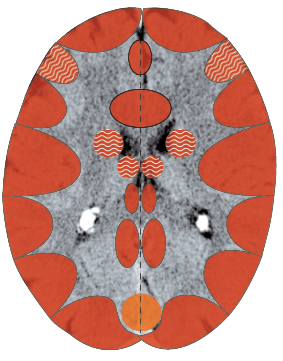
Normal pressure glaucoma, damage to or “stroke“ of the optical nerve
It is not certain if increased pressure within the eye poses a problem for the optical nerve. The fact of the matter is that the optical nerve is damaged just as often under normal pressure. According to CM, because of thromboses in the optical nerve’s blood vessels, which in my opinion which is incorrect, the blood vessels are arranged as a network. If this were the case, blockages could always detoured collaterally (see: p.153).
| Conflict | One does not want to integrate the information seen. One is annoyed. Self-esteem and self-respect component. = Intense eye(s) conflict. According to my experience, the person affected is usually hit by more than one thing at a time, pushing them over the limit they can handle. |
|---|---|
| Examples | ➜ “This is really getting on my nerves!“ A male nurse is unable to work anymore and goes to the job center. He is annoyed by all the paperwork and correspondence with the social security agency and the job center. He is diagnosed with a normal pressure glaucoma with damage to the optical nerve. (Dr. Odum) A male nurse is unable to work anymore and goes to the job center. He is annoyed by all the paperwork and correspondence with the social security agency and the job center. He is diagnosed with a normal pressure glaucoma with damage to the optical nerve. (Dr. Odum) The wife of the 68-year-old patient contracts Parkinson‘s disease. At the same time, his mother-in-law, who lives in the same house, becomes unable to care for herself due to dementia. Half a year later, the patient loses half of the sight of his right (partner) eye. Diagnosis: damage to the optical nerve due to stroke of the optical nerve. (Archive B. Eybl) The wife of the 68-year-old patient contracts Parkinson‘s disease. At the same time, his mother-in-law, who lives in the same house, becomes unable to care for herself due to dementia. Half a year later, the patient loses half of the sight of his right (partner) eye. Diagnosis: damage to the optical nerve due to stroke of the optical nerve. (Archive B. Eybl) |
| Conflict-active | Cell reduction, decrease in function of the optical nerve, possibly also due to limited blood supply > disturbances in the field of view or loss of sight. |
| Bio. function | Blocking out the unbearable for the protection of the individual. „Better to be half blind than to have to see that.” |
| Repair phase | Recovery depends on the conflict mass. Regeneration is usually incomplete. |
| Questions | When did the symptoms begin? (Conflict must have taken place some weeks before and have continued more or less until the present). What annoys/burdens me so much? Are there multiple, simultaneous unresolved problems? Which conditioning has led me into the dilemma? (E.g., perfectionism, wanting to do everything immediately, sloppiness)? Are there similar patterns among ancestors? (Indication of conditioning) Why am I doing it the same? Which new attitude was helpful? Which new internal and external changes? |
| Therapy | Determine the conflict and conditioning and resolve them in real life. Find out where the love is – there you’ll find the solution. See also therapy for macular degeneration p. 121. Guiding principle: “I couple myself with God‘s power and serenity. From now on, life will be easy.“ |
Closed-angle glaucoma, open-angle glaucoma
The most difficult chapter of eye medicine – also for us:
- Closed-angle glaucoma = narrowing of the space between the iris and the cornea > disrupted drainage > increased pressure in the inner eye. The cause is an SBS of the iris in the active-phase (see: p. 94) > swelling > narrowing of the angle.
- Open-angle glaucoma: First possibility: SBS of the vitreous body in the repair phase > increased intraocular pressure (p. 117). Second possibility: resistance to drainage in the scleral venous sinus canal due to cell growth or muscle contraction: visual-chunk conflict (see explanations p. 15, 16) that one cannot let go of/release something that has happened (e.g., a fight between grown children, daughter’s unhappy marriage).
- Another cause of increased inner pressure: SBS of the ciliary body: Visual-chunk conflict (see: p.116) > cell division in the active–phase > increased fluid production. Bio. function: Better vision through increased vitreous fluid. Example: A man desires a woman, but she does not reciprocate. He produces more vitreous fluid for the “magnifying effect“: In this way, he is subjectively closer to the one he adores. Diagnosis: glaucoma. (Archive Dr. Odum)
Reduced functioning of the retina, retinal edema, retinal detachment1
| Conflict | Fear-of rear-attack conflict. Fear of a thing or a danger from behind that cannot be shaken off. “Makes the hair on the back of your neck stand up.“ According to Dr. Odum, also a guilt-shame theme. |
|---|---|
| Example |  A patient lends an acquaintance a large sum of money. Suddenly, he is seized with the fear that he has fallen into the hands of a swindler – fear-of rear-attack conflict. (Archive B. Eybl) A patient lends an acquaintance a large sum of money. Suddenly, he is seized with the fear that he has fallen into the hands of a swindler – fear-of rear-attack conflict. (Archive B. Eybl) An owner of a small construction company lets the firm deliberately go bankrupt in order to get a tax advantage. However, the tax authorities are onto his scheme. He is afraid of a financial audit nearly every day. (Archive B. Eybl) An owner of a small construction company lets the firm deliberately go bankrupt in order to get a tax advantage. However, the tax authorities are onto his scheme. He is afraid of a financial audit nearly every day. (Archive B. Eybl) A retired, 67-year-old woman suffers a fear-of rear-attack conflict when her doctor tells her the following: “You were a smoker in the past. Your breathing difficulties are dragging out so long that we need to find out whether something malignant has formed.“ The woman sees this as a cancer diagnosis. Later, when her fears are allayed, she comes into healing. Now a retinal detachment is diagnosed. (See Johannes F. Mandt…Was Gesund Macht, p. 67). A retired, 67-year-old woman suffers a fear-of rear-attack conflict when her doctor tells her the following: “You were a smoker in the past. Your breathing difficulties are dragging out so long that we need to find out whether something malignant has formed.“ The woman sees this as a cancer diagnosis. Later, when her fears are allayed, she comes into healing. Now a retinal detachment is diagnosed. (See Johannes F. Mandt…Was Gesund Macht, p. 67). Someone finds out that his job at the company is “shaky.“ (Archive B. Eybl) Someone finds out that his job at the company is “shaky.“ (Archive B. Eybl) A patient has a car accident. He is afraid that he will lose his driver‘s license = fear-of rear-attack conflict. (Archive B. Eybl) A patient has a car accident. He is afraid that he will lose his driver‘s license = fear-of rear-attack conflict. (Archive B. Eybl) |
| Conflict-active | Clouding of the retina, partial occlusion of the range of vision (scotoma), reduced sight. |
| Bio. function | What one is afraid of should be made “invisible“ by means of a temporary interruption in the functioning of the retina. |
| Repair phase | Edema between the sensory cell layer and the pigmented epithelium. It only rarely comes to a detachment of the pigmented epithelium from the choroid. Even rarer is a splitting of the retina (retinoschisis). There is usually a loss of sight in part of the field of vision (“blind spot,“ scotoma, flashes of light). The worsening of vision is dramatic if the retinal detachment is near the macula where vision is sharpest. Relapses cause callosity, that is, scar tissue is formed. Usually, a recurrent conflict. |
| Note | By all means, flashes of light should be looked into by an ophthalmologist. Syndrome (see p. 277ff) aggravates the situation as it causes even more fluid to be stored! With the left half of the retina, the right-handed person looks to the right to the partner and with the right half of the retina, to the left to mother/child. If the left side of the retina of a right-handed person is affected, it is about the partner. If the right side of the retina is affected, it is about the mother/child. In contrast to the opinion of Dr. Hamer, I believe that diabetes really does aggravate diseases of the retina (diabetic retinopathy) as is maintained by CM. |
| Questions | Which stress was released before the retinal edema appeared? Fear lingers behind you? (E.g., mother-in-law, credit, tax authorities)? Which conditioning lies behind it? (E.g., insecurity, perfectionism)? |
| Therapy | The conflict is resolved. Support the healing. If it recurs, determine the conflict and conditioning. Conventional laser therapy: Here, the still intact edges of a detached retina are attached by pinpoint burning. This prevents an enlargement of the detached area. The price for this “safeguarding” is irreparable scarring (caused by the laser burns) > limited vision. Laser treatment is therefore not a curative, but a preventive measure. Retinal edemas don’t need to be burned with lasers; you can wait until the edema subsides. The two retinal layers reattach themselves to each other when the conflict is resolved and remains resolved for good. > The use of lasers is justified for major retinal detachments. If recurring, guiding principles: “I am safe and taken care of.“ Alkaline diet (see p. 65) rich in vital elements. MMS (see p. 68). Enzyme preparations. Garlic and lemon drink cure. Hydrogen peroxide (H2O2) 3% internally. Bach flowers (see p. 59): aspen, mimulus, star of Bethlehem. Neck/face lymph drainages (see p. 68), acupuncture, acupoint massage (see p. 68). |
Macular degeneration
In the center part of the retina – “yellow spots” in Latin: stains (macula lutea) – the vision cells lie extremely close together. This is where vision is the sharpest.
Most vision takes place in the macula.
In the case of macular degeneration, the cells in this area begin to die off.
The patient can no longer see the object, the eye is fixed on sharply, although he can see the peripheral area well.
Other symptoms: reduced strength of vision, sensitivity to being blinded by light, disturbances in seeing colors and contrast.
CM differentiates between “wet“ and “dry“ forms of the disease. According to CM, the cause of macular degeneration is unknown.
Dry macular degeneration
An SBS of the retina (see: p.119). Dry MD is diagnosed in more than 80% of those affected.
Sometimes the dry MD turns into wet MD. During ophthalmoscopy, so-called drusen = dead sensory cells, can be seen in dry macular degeneration. Conventional medicine essentially has no therapy for this.
| Conflict | Something that is centrally important is not discovered/not seen/stubbornly ignored. According to Dr. Odum: A special form of a fear-in-the-neck conflict: Negative expectations, guilt, shame and disgrace. |
|---|---|
| Phase | Persistent active conflict. Decline of sensory cells (“geographic atrophy”) as long as the conflict remains unresolved. |
| Bio. function | Blocking out the ugly/threatening/shameful reality. |
| Note | In my experience, serious illnesses like this are usually caused by a large unresolved family/ancestor issue. Therefore, don’t get hung up on the trigger, look deeper instead. |
| Questions | What fear is breathing down my neck? (Job, retirement, family, worry about children, grandchildren) family: Was an ancestor affected? If so, which themes accompanying the life of the family have been ignored? (Taboos, blind spots) What aren’t we supposed to see? Where are we afraid to look? What should remain hidden? What do I desire most in life? (Note on conflict and resolution) What meaning could the disease have for me? |
Wet macular degeneration
Wet MD is often a transition from dry MD. It is more problematic – here, choroidal vessels migrate into the degenerated retina. According to Dr. Odum, wet macular degeneration is an eyesight survival program. The choroid (see: p.116) fills the gap left by the dying retina with new cell growth.
Conflict/quest. See dry MD, additional fear, feeling undersupplied in the ideal sense (starved like the retina).
Retinitis Pigmentosa (RP)
In this condition, the retinal sensory cells increasingly disappear from the periphery – effectively the counterpart to macular degeneration (where the center is affected). With RP, the field of vision is restricted from the outside.
| Conflict | Someone is fanatically fixated on their own things, only sees their own goal and loses any sense of anything else. To avoid their own downfall, they don’t look to the left or right. Issues: stubbornness, ignorance, fanaticism. According to Dr. Odum: Blocking out the horrible visions through hyperpigmentation. Phrase There is a German phrase that roughly translates to: “Tunnel vision always has a blind spot behind it.” |
|---|---|
| Phase | Persistent conflict. Restriction of the field of vision (tunnel vision) from the outside, impaired vision at twilight and distinguishing contrasts. More rarely, however, the restriction of the visual field can also start on the inside (= inverse RP). |
| Therapy | There is no standard therapy for RP. See therapy for macular degeneration p. 121. |
1 See Dr. Hamer, Charts, pp. 141,146
Red-green color blindness (color vision deficiency)
This is an “hereditary disease” and this is why we must place our focus on the ancestors. Those affected (10% of men, but only 0.5% of women) have difficulties distinguishing the colors red and green from one another.
| Conflict | According to Frauenkron-Hoffmann: Not wanting to see something green or red. Ancestral conflict in connection with these colors. Stress during an ancestor’s experience with these colors. |
|---|---|
| Example |  An 8-year-old boy can’t distinguish between red, green and violet. Mrs. Frauenkron-Hoffmann identified the following conflict for the color red: His parents decide to have the child when the mother is already 30. Unfortunately, they aren’t successful for two years. Every time when the mother saw that she had her period (blood – red), she experienced stress – her time was running out. The other colors that he can’t see also have something to do with his ancestors. As soon as the boy recognized the connection and understood that the stress is now over and didn’t actually have anything to do with him, he could see all colors. (www.biologisches-dekodieren.de) An 8-year-old boy can’t distinguish between red, green and violet. Mrs. Frauenkron-Hoffmann identified the following conflict for the color red: His parents decide to have the child when the mother is already 30. Unfortunately, they aren’t successful for two years. Every time when the mother saw that she had her period (blood – red), she experienced stress – her time was running out. The other colors that he can’t see also have something to do with his ancestors. As soon as the boy recognized the connection and understood that the stress is now over and didn’t actually have anything to do with him, he could see all colors. (www.biologisches-dekodieren.de) |
| Conflict-active | Impairment of the ability to see specific colors, usually from birth onward. Wether the problem lies with the retina (perception) or with the visual cortex (processing), doesn’t play a main role for us. |
| Bio. function | Blocking out the color to protect the individual from the stress associated with it. |
| Repair phase | Restoration of color vision. |
| Note | Mrs. Frauenkon-Hoffmann explains why 20 times more men are effected by red-green color blindness in this way: Many of our male ancestors died on the battlefield (blood – red, field – green). |
| Questions | Which color(s) does it involve exactly? Is this vision deficiency also present in ancestors? (Indication that the conflict is to be sought there). Which stress ancestor(s) have with that color? Was there stress with blood at the time? Did someone die tragically on a battlefield (green). What do I think about with this color? Which role does this color/this associated something play with an ancestor(s)? |
| Therapy | Determine the conflict, triggers and causal conditioning and resolve them. See also Therapy p. 121. |
Total color blindness (achromatopsia), day blindness (hemeralopia)
We categorize those people as color blind who can only see white-gray and no colors. Because color blindness is hereditary, we have to look for the conflict among ancestors.
| Conflict | Light or daylight is dangerous, because one can be discovered. In the figurative sense: The light of recognition hurts. One doesn’t want to see the skeletons in the closet – a test of honesty shouldn’t be ruled out. Also: One’s sight/judgement is limited to black or white. One has forgotten how diverse, colorful and many-facetted life is. One shuts out the light. |
|---|---|
| Examples | ➜ The soldier can only advance at night. He would be shot at the break of day. ➜ On the run: The hiding place is only safe at night. They’ll be discovered during the day. |
| Bio. function | Blocking out of all colors so that the individual believes they are safe. In white-gray, one feels better. |
| Conflict-active | Limitation of the ability to see colors, usually from birth onward. |
| Repair phase | A complete restoration is probably not so easy here. It depends on whether color receptors in the retina are present and functional. |
| Questions | Did ancestors also have this vision deficiency? Which stress did an ancestor(s) have once in the daylight? Did someone need the protection of the night? Dramatic war, criminal or refugee experiences? Have I or did my ancestor(s) suppress something monstrous? (E.g. murder, incest)? Has someone completely shut out the Light (of God) and sought their salvation in darkness? |
| Therapy | Determine the conflict, triggers and original conditioning and resolve them. See also treatment p. 121. |
Nearsightedness (shortsightedness, myopia)
In CM, one differentiates between two types of nearsightedness:
- By so-called axial nearsightedness, the eyeball, instead of being perfectly spherical, is slightly elongated. This results in the focus lying in front of the retina instead of on it > seeing in the distance is out of focus and blurred > nearsightedness. (An elongation of the eyeball by 1 millimeter results in a nearsightedness of about 3 diopters.)
- The second, rarer kind of nearsightedness is refractive nearsightedness. Cornea and lens refract the light too strongly. Here too, the focal point lies in front of the retina > nearsightedness. In the following, I describe three possible biological changes that occur with nearsightedness. After that, I present some conflict causes and case studies.

Eyeball too long
Focal point in front of the retina

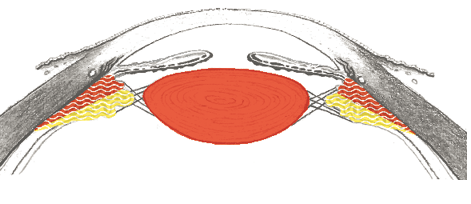
Ciliary Muscle
Nearsightedness caused by the ciliary muscle
According to CM, the ciliary muscle is an involuntary muscle. According to Dr. Hamer, it has involuntary and voluntary (striated) parts, which seems perfectly logical to me. In the following, I take both possibilities into consideration.
The ciliary muscle plays the main role in refractive nearsightedness. The interplay between this parasympathetic innervated ring muscle, the zonula fibers (suspension apparatus), and the lens is not easy to understand. In a tension-free state, the lens is a roundish, thick disk, which is connected with the ciliary muscle over the zonula fibers.
- When the ciliary muscle tightens, the inner diameter of the ciliary body diminishes > the zonula fibers, on which the lens hangs, relax > the lens takes on its original form of a roundish thick disk = nearsighted adjustment.
- When the ciliary muscle relaxes, the inner diameter of the ciliary body increases > the zonula fibers tighten > they pull on the lens > it becomes a flat disk = farsighted adjustment. Thus, the tension of the ciliary muscle behaves inversely to the tension on the lens. Tightened ciliary muscle > relaxed, thick lens. Relaxed ciliary muscle > tightened, flat lens. The “antagonist“ to the ciliary muscle is the inherent tension of the lens.
| Progression | Involuntary part of the muscle: Increased muscle tension in the active-phase > better seeing up close (= bio. function) > nearsightedness, if the conflict is active for a longer period. Voluntary (striated) part of the muscle: Necrosis or paralysis in the active-phase. Refilling in the repair phase. End of the repair phase or in persistent repair: the ciliary muscle is stronger than before (luxury group) > nearsightedness. |
|---|---|
| Non-conflictive | It is very probable that nearsightedness can also happen with out a conflict with regard to the ciliary muscle and diagonal eye muscles: adjustment to constant near-vision use (school, computer, etc.). |

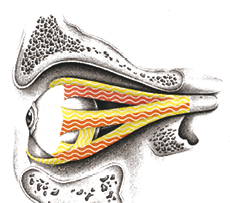
Inferior Oblique Muscle
The role of the outer eye muscles is underestimated in CM: e.g., focusing on an image.
The New York ophthalmologist and founder of eye training, Dr. Bates (1860-1931), researched the cause of nearsightedness for more than 40 years. He observed that the vision among his students varied greatly. He noticed that patients, whose lenses had been removed could see fairly well nevertheless (accommodation). This is something that simply should not occur according to the textbooks.
His credo: “The lens is not the main factor in the accommodation process.“ He discovered that the lens, when focusing, was aided by the upper and lower, oblique eye muscles. These two muscles build a ring around the eyeball. When they tighten simultaneously, the eyeball is squeezed lengthwise > improvement of near sight. Permanent tension of these muscles results in nearsightedness!
Dr. Bates and representatives of modern ophthalmology schools start from the standpoint that near vision under stress leads to lasting tension of these muscles. The body does nothing other than accommodate the (somewhat unnatural) demand for permanent near vision (nearsightedness – an adaptation process).
Eye training is an attempt to release the tension in these muscles.
This adaptation theory of Dr. Bates is confirmed by the fact that the numbers of nearsighted people increase with the level of civilization. In Japan, over 90% of the youth are nearsighted, among indigenous peoples, hardly any.
Nearsightedness due to cone-shaped thinning of the cornea (keratoconus)
A persistent, active conflict of the cornea causes it to become thinner and thinner. This results in the loss of its regular curvature and it becomes cone-shaped, pointing to the front = keratoconus > usually linked to a distortion of the cornea. This type of myopia can be clearly diagnosed. It cannot be completely compensated with glasses. Due to the increased corneal curvature, the light is increasingly refracted > myopia.
| Conflict | Strong visual-separation conflict. To lose sight of somebody. |
|---|---|
| Phase | Persistent, active conflict |
Nearsightedness: conflict, examples, therapy
| Conflict | First possibility: A person has the feeling that he does not belong. Someone or something is too far away. He misses somebody. “I would like to have a certain something or someone within sight of me.“ |
|---|---|
| Bio. function | A visual clinging to someone or something. The nearsightedness gives the illusion of being in a small, safe, and intact world. |
| Conflict | Second possibility: A person does not want to see something in the distance, because it frightens them. |
| Bio. function | Visually blocking something out. Subconsciously, one only wants to see in the near vicinity to feel safe or secure. “What I cannot see in the distance cannot scare me.“ Type of person Most often, people who tend to be introverted, fearful or hesitant are affected. |
| Examples |  While a boy is attending a summer camp, the other boys gang up on him and beat him. After these three weeks, he is nearsighted. A test of his vision shows a diopter of minus 1.5. (Archive Dr. Odum) While a boy is attending a summer camp, the other boys gang up on him and beat him. After these three weeks, he is nearsighted. A test of his vision shows a diopter of minus 1.5. (Archive Dr. Odum) A child has to go to kindergarten. He does not like it there and would much prefer to be at home with his mother. (Archive B. Eybl) A child has to go to kindergarten. He does not like it there and would much prefer to be at home with his mother. (Archive B. Eybl) |
| Questions | When did the nearsightedness begin? (Conflict must be previous). What is frightening “out there?” Why? Why do I want to retreat? Did ancestors have similar tendencies? (Look for conditioning). |
| Therapy | Determine the conflict and conditioning and resolve them in real life. Avoid looking at things close up at an early age and avoid early learning pressure. Spend more time in nature rather than with television and books. Eye training (see bibliography.). Bach flowers (see p. 59): aspen and mimulus among others. Until 1850, one rightly assumed that eyeglasses made bad eyesight worse and thus, they were not prescribed. In any case, it seems sensible not to fully correct the eyes, so that room for improvement remains. |
Farsightedness (hyperopia)

Eyeball too short
Focal point behind the retina
In the case of farsightedness, the eyeball is too short in relation to the refractive power of the seeing apparatus > blurriness when looking at objects up close.
Possible causes
- Farsightedness as an aging process? Yes, this might be true for those over 45; however, this surely does not apply to young people, because they sometimes become farsighted too. The fact is that the rigid core of the lens becomes enlarged with age, which is a burden on the elastic outer layer. This causes the lenses to lose their overall elasticity > without elasticity, sharp eyesight (accommodation) is not possible!
- SBS of the outer eye muscles: Tension in the smooth eye muscles causes the eyeball to shorten = distance vision adjustment (see: p.112). In the case of a conflict, the tension can become permanent = farsightedness.
- SBS of the ciliary muscle: Weakness or paralysis of the ciliary muscle due to a conflict > tension in the zonular fibers > a tug on the lens > it causes it to become a flat disk = farsightedness.
- Callosity: Dr. Hamer explains farsightedness, as a shortening of the eyeball due to callosities in the rear (dorsal) part of the eyeball (see p 117).
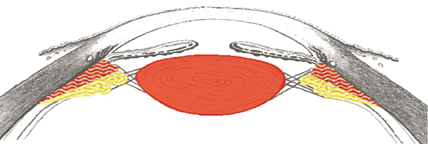
Lens
Ciliary muscle
Medial rectus muscles
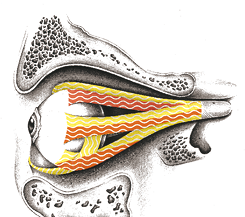
| Conflict | Not being able to see someone or something that is far away. Visual wandering and searching. “I want to see whatever is out there carefully since it might be dangerous!“ |
|---|---|
| Example |  A little boy always wants to carry his favorite toy around with him. Suddenly, his parents take it away from him. Within a short time, he develops farsightedness with a diopter of plus 7. The boy keeps looking and looking. (Archive Dr. Odum) A little boy always wants to carry his favorite toy around with him. Suddenly, his parents take it away from him. Within a short time, he develops farsightedness with a diopter of plus 7. The boy keeps looking and looking. (Archive Dr. Odum)SBS Medial rectus muscles and/or ciliary muscle. |
| Bio. function | Good, long-distance eyesight in order to recognize someone or something more easily. |
| Phase | Persistent active conflict. Type of person Outward-oriented (extroverted) and energetic persons (“go getters“) tend to be affected more often. |
| Questions | Farsightedness substantially before the age of 45? (> Look for the conflict’s cause). What is frightening out there? What am I looking for in the distance? Which conditioning is this based on? (Parents, ancestors)? |
| Therapy | Determine the conflict or conditioning and, if possible, resolve them in real life. Eye training can decidedly improve or stabilize farsightedness. However, this requires commitment, diligence, and perseverance. (For books, see bibliography). “As long as I live, I will remain curious and flexible.“ “I forgive myself and I forgive you.“ |
Astigmatism
With astigmatism in CM, there is not a single focal point in front of the retina (nearsightedness) or behind the retina (farsightedness), but rather two or more focal points. This phenomenon is aptly called “lack of focal point.“
Deformation of the cornea is the most common cause of astigmatism, but there are others: astigmatism of the lens (rare) and astigmatism of the eye background (retina).
Possible causes
- SBS of the cornea (thinning of the cornea p. 114).
- SBS of the outer eye muscles: Varying amounts of tension in the outer eye muscles that brace the whole eyeball, so that symmetry is lost (see strabismus). See: p.112. The asymmetry can affect the cornea or the retina.
- SBS of the vitreous body: A pulling of the vitreous body on the retina in the active-phase > distorted vision (see: p. 95f).
| Conflict | A person‘s internal vision – their expectations (of oneself or of others) – do not match reality. The two views cannot be brought into alignment. |
|---|---|
| Examples |  A child has a natural inner vision of a strong father. The father, however, is a dialysis patient. Unfortunately, one day his mother takes him to the hospital where he sees his ailing father, who is dependent on dialysis. (Archive Dr. Odum) A child has a natural inner vision of a strong father. The father, however, is a dialysis patient. Unfortunately, one day his mother takes him to the hospital where he sees his ailing father, who is dependent on dialysis. (Archive Dr. Odum) The father of a patient – 5 years old at the time – has become an alcoholic. He is drinking with his buddies and starts showing off his son‘s gymnastic stunts: “Hey look, he can do a headstand on a shot glass.“ For the boy, this is terribly embarrassing. He has to perform the stunt dressed only in his nightshirt. The real picture of his father does not match his inner vision. (B. Eybl) The father of a patient – 5 years old at the time – has become an alcoholic. He is drinking with his buddies and starts showing off his son‘s gymnastic stunts: “Hey look, he can do a headstand on a shot glass.“ For the boy, this is terribly embarrassing. He has to perform the stunt dressed only in his nightshirt. The real picture of his father does not match his inner vision. (B. Eybl) |
| SBS/Phase | Cornea and/or external eye muscles. Persistent conflict. |
| Bio. function | The distortion of reality protects the individual from the “hard reality.“ |
| Questions | When did the symptoms begin? (First conflict must have been before this. The diagnosis usually takes place after the first symptoms > estimate when the SBS began). Which expectations didn’t match up with reality at the time in question? Is the conflict still ongoing? What could be recurring? Why do I have such high expectations? Which conditioning has made me into who I am today? (Pregnancy, birth, parents)? |
| Therapy | Determine the conflict and conditioning and, if possible, resolve them in real life. Astigmatism can be improved considerably through eye training. |
| Author | Title and Overview | Keywords | ||||
|---|---|---|---|---|---|---|
 | 2024/07/21  Ein Ereignis, das mehrere SBS notwendig machte. | kalter Schweiß, Linksherz-Myokardinfarkt, Brechdurchfall, Schüttelfrost, Nachtschweiß | ||||
 | 2024/05/28  Beim Färben der Haare wurde die Farbe verwechselt und einige der Haare versehentlich rot gefärbt, was ein visueller Schock für sie war. Wochenlang litt sie unter ihrem Anblick, bis sie eine Lösung gefunden hat - am nächsten Morgen traten die Gerstenkörner in der konfliktgelösten Phase auf. Doch die Lösung war nicht stabil, sodass ein erneutes Rezidiv auftrat... | Meibom-Drüsen | ||||
 | 2024/05/28  Am Samstag hatte ich mit meinem Mann Brennholz gemacht. Ich hatte nur ganz leichte Stoffturnschuhe an. Plötzlich warf er mir einen dicken Brocken Holz direkt vor meinen Fuß und ich habe mich in dem Moment voll erschrocken, weil ich echt Angst um meine Zehen hatte... | |||||
2024/05/19   After two years abroad, the young woman returned to Germany, which was very difficult for her, as she felt absolutely powerless to return to Germany: arguments with her parents, no apartment, no partner, no job - this situation represented a conflict of powerlessness for her... | Thyroid excretory ducts, gill arch ducts | |||||
2024/05/19  Frau Frau S hat 9 Monate unbeabsichtigt eine Führungsposition übernehmen müssen, obwohl sie dies ganz und gar nicht wollte. In dieser Zeit hat sie mit Nackenschmerzen rezidiviert und war sich bewusst, dass sie für viele Monate stark konfliktaktiv war - sodass sie mit großer Sorge auf die gesundheitlichen Auswirkungen nach zukünftiger Konfliktlösung geschaut hat, die dann natürlich auch kamen. | Kleine Kurvatur des Magens, Revierärger-Konflikt | |||||
2024/05/15   In this testimonial video, Tanja talks about her successful resolution of hay fever / allergic rhinitis based on the 5 Biological Laws of Nature. This has existed for three years since 2019 and has now been absent for the last two years. Congratulations and a thousand thanks for sharing this valuable experience (in german, but you can activate english subtitles)! | Allergy, hayfever | |||||
 | 2024/05/07   Every year, as soon as I observed the leaves falling from the trees, I would get rough and dry skin on the exterior surface of my hands for months and could not sleep well in my bedroom (only in the living room). | Allergy, dry hands, sleep problems | ||||
 | 2024/04/24   Tonsillitis/angina bilateral information-chunk conflict with syndrome | |||||
 | 2024/04/08   Every evening I fell into bed exhausted and couldn't sleep. My tingling legs didn't leave me alone. Going to the cinema was also unbearable because I had to sit still. | Partially resolved motor conflict, renal collecting duct syndrome | ||||
 | 2024/04/05   This report is about the importance of letting yourself know that the situation that led to the symptoms will not happen again. I told myself directly: it will not happen again, because the people who were involved will no longer be around me. 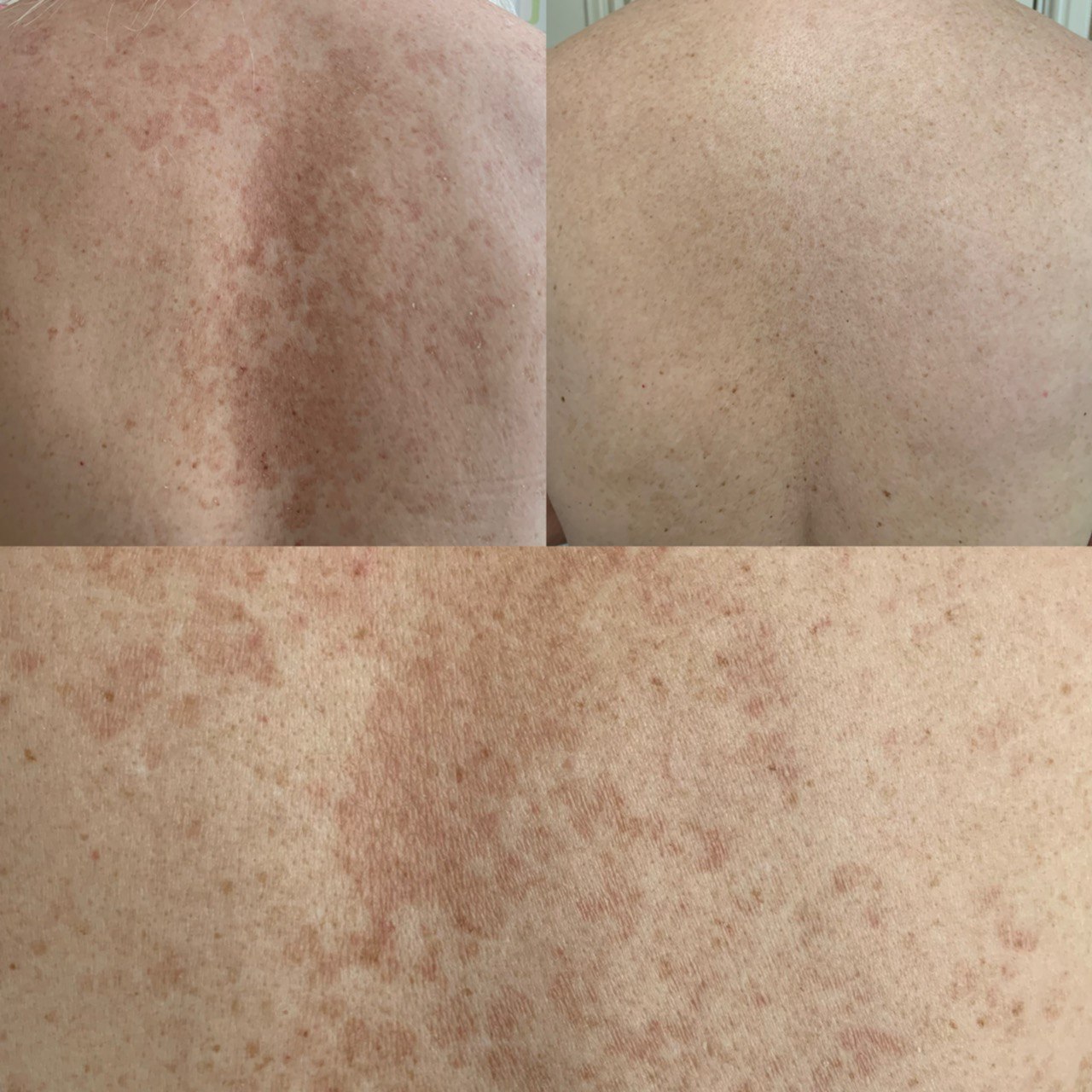 | |||||
2024/03/26   Formation of small brown spots on the breast due to a mother's rough, painful breastfeeding experiences. And disappearance of these due to later, more pleasant experiences. | ||||||
 | 2024/03/22   I suspected a strange car in our parking lot. As I drove closer, I saw that my parking space was free and I could park without worrying. Based on my perception, I came upon an old association with physical symptoms for a few days. The morning after, a sore throat started for 2 days. On the 2nd day there was a watery nose on the left. On the 3rd day the discharge became purulent, only on the left. Now it is the 6th day and the nose is still purulent. | Weather, perception, territorial fear | ||||
 | 2024/03/10   Realization of a biological conflict when the national borders were closed during the Corona period. Self-diagnosis through knowledge of the 5BN during the conflict active phase, but the symptom disappeared at some point. Conflict active for many weeks. No memory of the solution. | Periosteal separation brutally unfair | ||||
 | 2024/03/10   Sweaty feet for years without interruption from about 1993 to about 2009 (date of resolution no longer known) I cannot remember the origin, it developed "somehow" in my life (perhaps I wore unsuitable shoes) Daily recurrence and resolution, so to speak Termination of the splint through realization of the biological mechanism. | besmirching dirt feet stink | ||||
2024/02/08   Once in my life, 20 years ago, I had left-sided epididymitis. As the report from many years ago somehow got lost, I'm posting it again now. | ||||||
2024/01/08   Another apparent injury that, without knowledge of the 5BN, would be misinterpreted as pure overload (and therefore often misinterpreted by athletes as "I'm getting old" / "I'm rusting"). | ||||||
 | 2023/12/26   My back pain began one weekend afternoon on a beautiful spring day, a short time after I finished changing the car tires. | back pain | ||||
 | 2023/11/28   The initial situation was a small accident with injuries to the front of the body, which subsequently resulted in back pain and tension. | |||||
 | 2023/11/23  Der erste Schlaganfall trat im Juli '17 auf. Aus dem Wissen um die 5 biologischen Naturgesetze können wir ableiten, dass es vorher eine Erleichterung bezüglich eines Bestimmten Problems gegeben haben muss. Der Schlaganfall tritt in der Heilkrise einer konfliktgelösten Phase auf in der sog. Heilkrise. Was war geschehen? | |||||
 | 2023/11/23  Das Symptom begann im Kindesalter am rechten Arm mit einem kleinen Fleck und weitete sich über Jahre aus. Heute bestehen die Flecken an der Innenseite der Arme und von der Achsel seitig runter zur Brust. | |||||
 | 2023/11/23  Vorgeschichte: Die 66 j. Frau wurde von ihrem Mann verlassen und hatte 2 Kinder. Alleinerziehend wolle sie ab 2005/06 den Lebensstandard für die Kinder aufrecht erhalten und nahm einen Kredit auf. Die Rate Betrug 300 € monatlich. Im laufe der Jahre wurde die Rate höher und sie nahm zwischenzeitlich noch mehr Kredit auf. Sie wusste, dass das alles zu viel für sie war, aber hat das immer verdrängt. ... 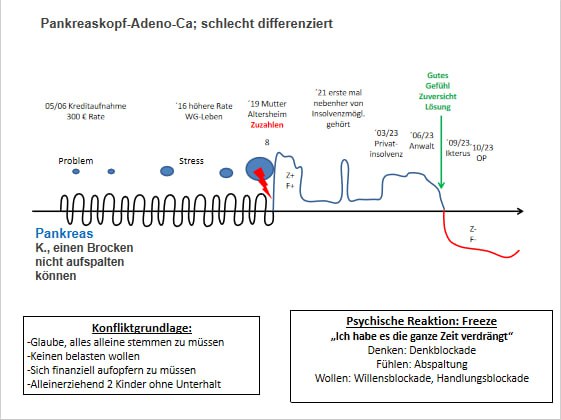 | |||||
2023/11/23   This video is about the causal event that led to "hay fever" and the various food allergies that gradually built on this. And, of course, the resolution by recognizing the causal connections! Congratulations on the successful resolution and many thanks for sharing this wonderfully instructive experience report (in german, but you can activate english subtitles)! | ||||||
 | 2023/08/26    This case describes the healing of an already advanced thyroid tumor with the conventional medical diagnosis: death.... and the resulting lung cancer. Which we have also got under control. | |||||
 | 2023/08/20   This is a case that occurred in a family with three children: 6 years, 4 years and 6 months. The eldest constantly takes the infant in her arms, although the mother does not welcome it. But the six-year-old sister breaks the ban from time to time. | chunk conflict, anger, trouble; territorial threat | ||||
 | 2023/08/06   This is the case of an acquaintance of mine who was passing through my house. I used to even envy her because her skin was always good. But this time red spots covered her face and neck. She told me that this has been going on for more than six months now. Efforts and use of different remedies have not brought improvement... 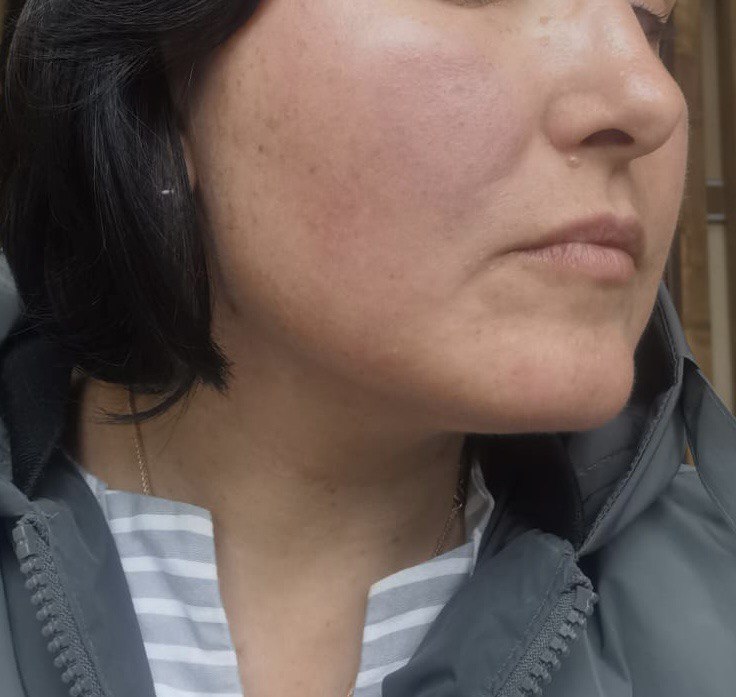 | Separation conflict, ectoderm | ||||
 | 2023/08/04   A student of my course asked me to help her with her symptoms. The woman thought it was a so-called fungus on her right foot (toes), it had been there for about three or four weeks. She has used the bathroom with other family members, no one has anything like this, her left foot is also fine. So the contagiousness theory has once again been defeated... 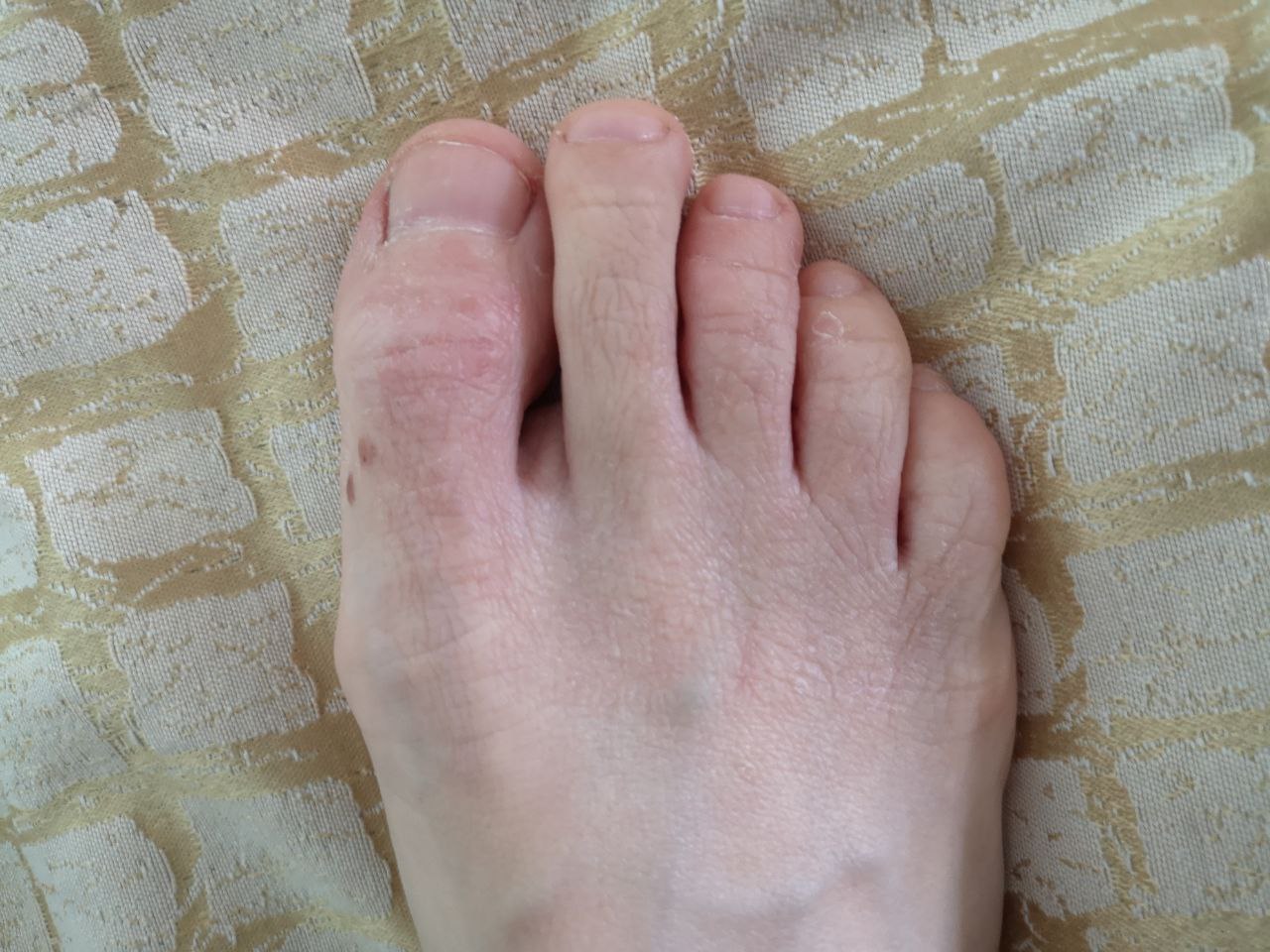 | Separation conflict, ectoderm | ||||
2023/08/02   Everyone who has a little to do with the 5BN/GNM knows this: You ask the person affected whether a solution / a relief was perceived shortly before the onset of PCLA symptoms and the answer is first: "There was nothing". For this I could make an interesting observation with myself: ... | Intellectual self-devaluation conflict | |||||
 | 2023/08/01   A woman (30, female hormone, right-handed) had been lactose intolerant for 15 years with symptoms of the small intestine (indigestible annoyance with the aspect of starvation). | allergy | ||||
 | 2023/07/29   Could it be that I am premenopausal? | |||||
 | 2023/07/29   Acid reflux, because something swallowed simply cannot be "accepted" and thus cannot be "digested" in the stomach. | |||||
 | 2023/07/29   I am called to a cat that has been vomiting its food again and again recently. | |||||
 | 2023/07/29   About 5 years ago I was at my daughter's school at the sports festival as a helper. I was assigned to a teacher and we both had a ward to supervise. So far, it was all fine and gave me pleasure, until I had to notice that the teacher was taking advantage of certain students - the boys. I was quite annoyed by it, but swallowed it and was glad when the whole thing was over. | |||||
 | 2023/07/29   When my daughter was in elementary school, about 2nd grade, I was away from home for a week and received the text message from my husband that she was very bad, 40 fevers, massive headaches. He felt reminded of his meningitis and said, maybe she had something like that now?? I was shocked and immediately demanded to talk to her and him on the phone. | |||||
 | 2023/06/07   Breaking off contact with an important person for 7 months. Then successful contact again with subsequent onset of symptoms (small red spots around the chest, abdomen and back). The spots appeared a little later, developed for 3 weeks and then went back again in 2-3 weeks until they disappeared completely. 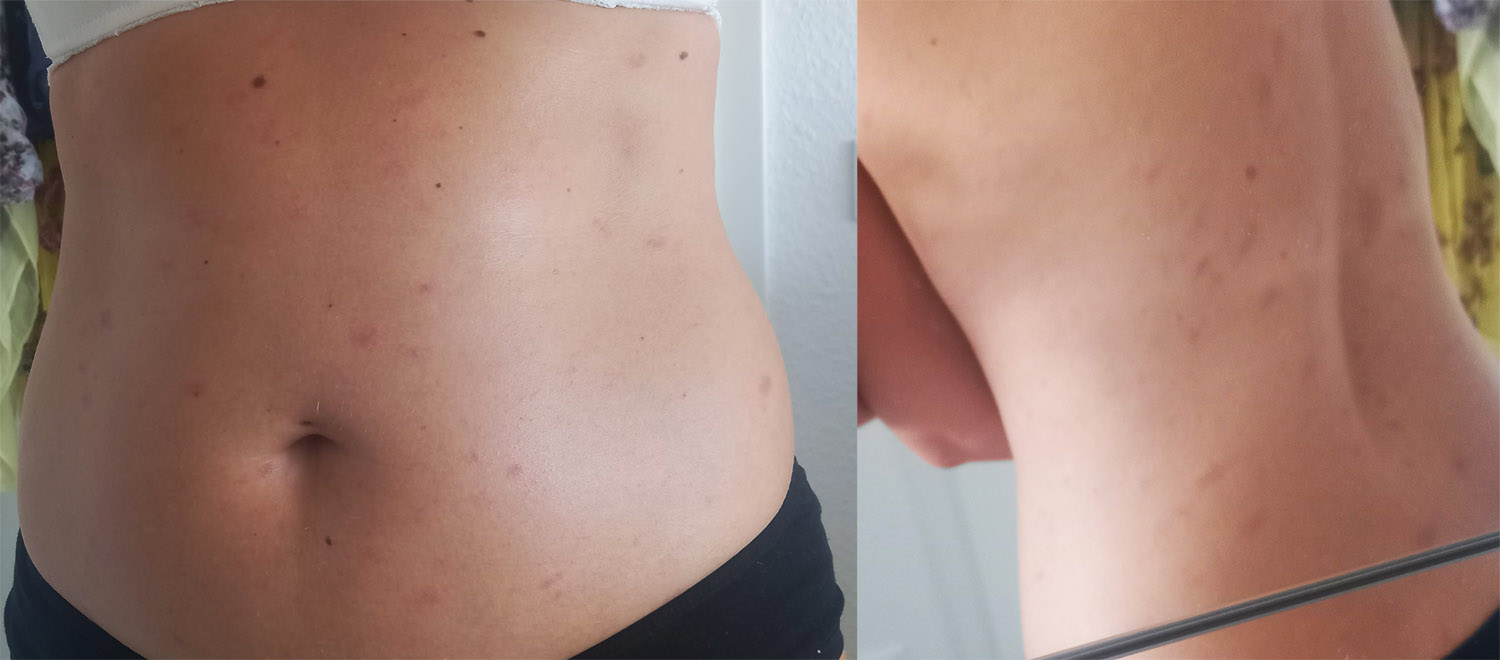 | |||||
 | 2023/05/27   A client suddenly developed pain in her right foot on a weekday at her workplace. She could hardly perform for a short time. The pain was on occurrence in the area of the structure of the heel bone and the ankle bone joint. The pain was both on stepping the foot and when the foot was flexed while walking. The pain went away in less than an hour. | heel bone hock joint | ||||
 | 2023/05/21   After wearing velvety-soft silk scarves, the client developed reddening of the skin with itching on the neck area, specifically on the back of the neck, not on the front. This skin reaction lasted for a day or two and then disappeared until she wore a silk scarf again. The phenomenon also occurred when she wore a pearl necklace on much rarer occasions. | epidermis | ||||
 | 2023/05/19   "In November 2002 I began to have upper abdominal discomfort. It was a pulling, stabbing pain. At first I mistook the pain for an upset stomach and tried to do my work as usual. But within a few days the problems increased..." This report was first published by Johannes F. Mandt on the website of the Kopernikus e.V. association. | |||||
 | 2023/04/17   A young boy is frustrated because he is not growing taller. His mother, very new to Germanische Heilkunde, has a moment of clarity to help him resolve his conflict. She isn't aware of the SBS; she just uses Germanic New Medicine and her knowledge of his history to help him move on and grow. | 11 year old wasn't growing | ||||
2023/04/15   Gunter speaks in this testimonial video about his successful resolutions of various suture intolerances (gluten, various meats, tomatoes, peanuts, raisins, and more) based on the 5 Biological Laws of Nature. Congratulations and thank you very much for this wonderful report! | Track, resolving allergies, resolving intolerances | |||||
 | 2023/03/07   A sore throat sets in just a few minutes after a soothing conversation, followed by hoarseness and coughing within the next few days. | |||||
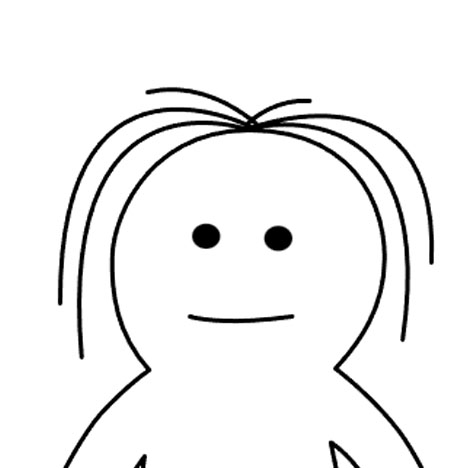 | 2023/03/06   This is an 8 year old right handed girl. She was born with clubfeet. Her foster mother is my friend. The daughter always complained about pain in her feet, which had been present since infancy... | |||||
 | 2023/03/06   The symptoms did not appear immediately after the hamster's death, but when the boy and his mother walked past the hamster's grave site weeks after the death. He stopped there, started crying terribly and said he missed him so much... | |||||
 | 2023/03/06   25-year vicious cycle of pain that was treated with increasingly powerful painkillers but was considered incurable by conventional medicine. Simply by identifying the causal situation and sharing/discussing these experiences, the cycle could be broken and complete healing achieved. | |||||
 | 2023/03/06   Increasing reddening of the skin and scaling on the forearm after my budgie bit me there by surprise. Resolution by recognizing the causal connection. 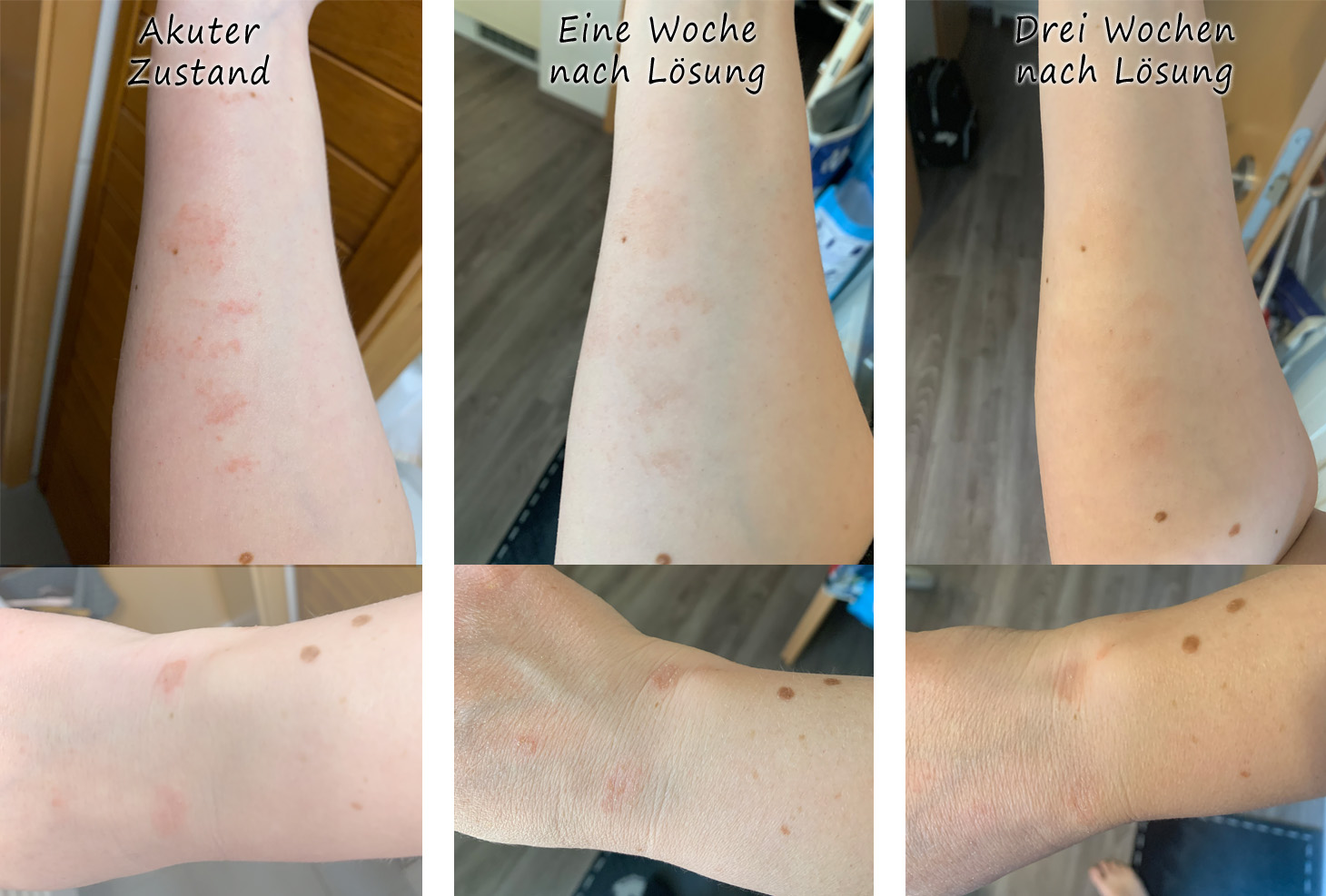 | |||||
2023/03/05    Three years ago, the mother washed cloth diapers full of pee again and again and was disgusted by the touch on the one hand, on the other hand she did not want this situation with the children. It developed extremely dry, cracked and painful skin on the outside of the hands. Recently, there was a similar situation again, according to which the symptom reappeared within hours and was therefore very well verified. 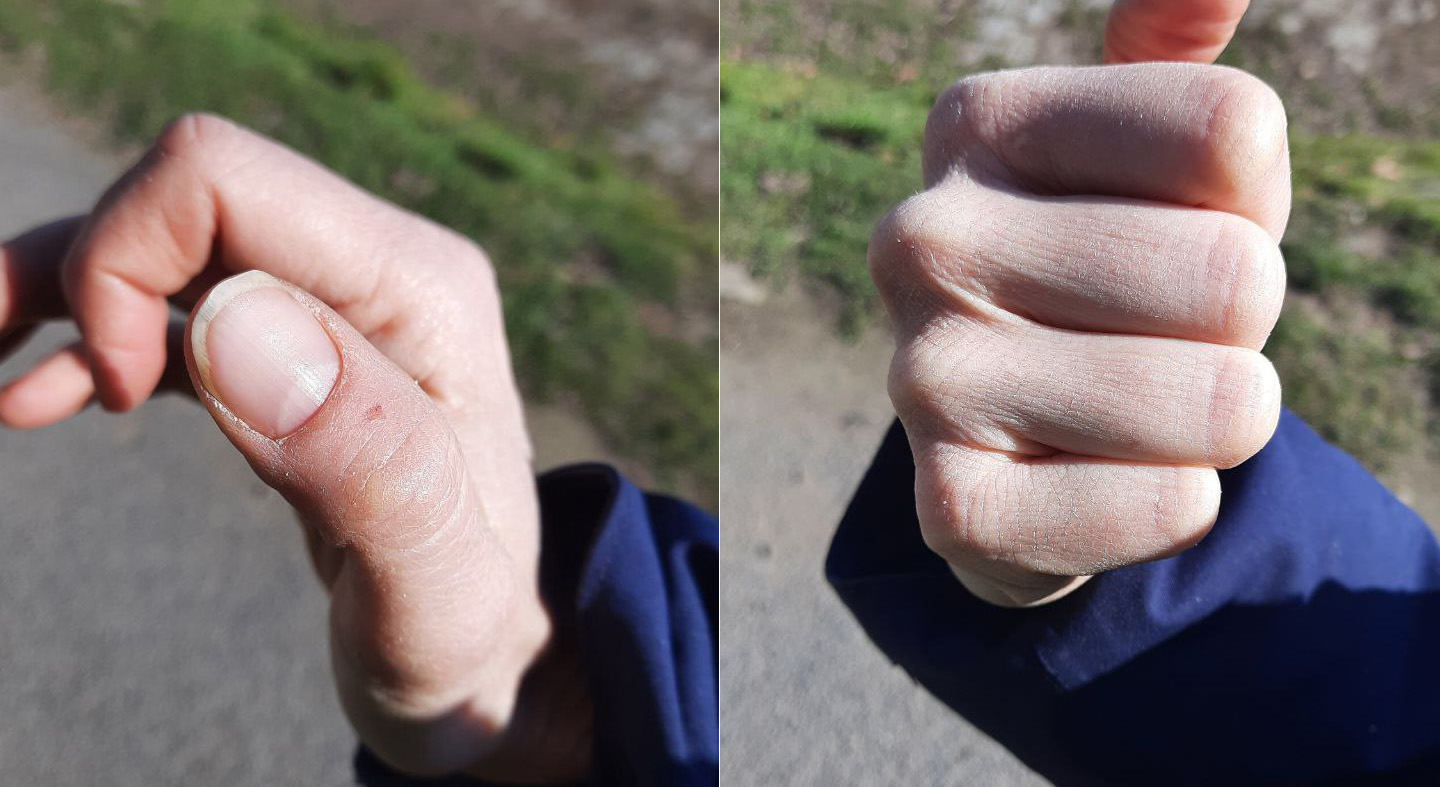 | ||||||
 | 2023/02/21    My best friend's wife has been diagnosed with cervical cancer and peritoneal cancer and has been treated by conventional medicine. After I wanted to help and pointed out the 5BN to him, he only looked at it for a few minutes, but spent many hours searching Google for hate articles on the subject and gave me a correspondingly dramatic feedback on this alleged "death cult". For me, this feedback was the Biological Conflict ("intellectual self devaluation conflict", I thought I had found a solution/help but couldn't help, felt I was treated unfairly), as this was my first attempt to interest someone in this topic - and I absolutely did not expect such a reaction ... | |||||
 | 2023/02/19    After buying new shoes from a certain brand, a burning sensation was felt on the soles of both feet shortly after putting them on. The burning sensation passed, but warts appeared on the balls of the feet on both soles of the feet in the following days. | |||||
 | 2023/02/04    The client had already had one of the canines in a repeated repair process for a few days. When she woke up one morning, she discovered an extra swelling on this side of her face in the cheek and upper jaw area. In the mouth area, she felt a thicker, more swollen strand above the affected tooth. | |||||
2022/10/08    A good friend and I had opinions and positions during the Corona period that could not have been more different. However, since we had not seen each other for more than a year during that time, we arranged to meet a few months later (winter 2021). At that time, his wife was pregnant. ... | "Indigestable anger" conflict, ileum, lower small intestine | |||||
2022/10/06    Just before our vacation trip this year, we found two half-dead garden sleeper babies on our doorstep (see photos). We took them in and cared for them. Our son experienced two self-esteem collapses when one animal died unexpectedly in his left hand during a car ride - and additionally when the second animal later jumped and escaped from the same hand. 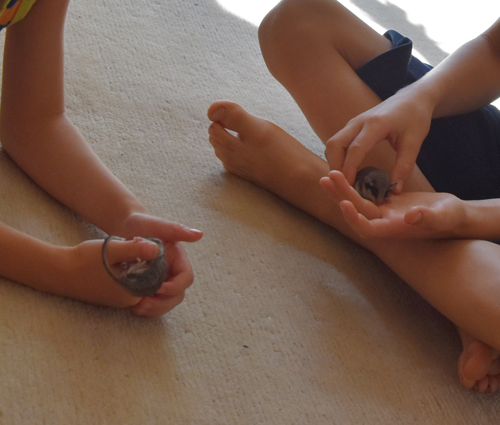 | ||||||
2022/10/06    This was the most intense and obvious conflict activity that we could observe in our son so far on the basis of the compulsive thinking. We were glad to be able to proceed in such a targeted way to lead the SBS so quickly - and therefore so unproblematically - through the conflict-resolved phase. | Dermatitis, skin rash | |||||
 | 2022/09/15    A woman with a breast cancer in the left breast | Breast Cancer | ||||
2022/08/04   The present case - documented with video excerpts - is about a 7-year-old boy with two phases of different tics or twitching. At the age of 5, he had a tic for about a month, during which he would always bend his knees a bit and tighten his arms. At 7, he had another tic for two months where he always extended both arms at the same time. | Tics, twitching, motor constellation | |||||
2022/07/31   Sima talks about her successful resolutions of her birch pollen and cat hair allergies based on the 5 Biological Laws of Nature in this testimonial video. Congratulations and thank you very much for this nice report! | Track, resolving allergies | |||||
 | 2022/07/25    One day, blood and a thin, light-yellowish-beige secretion came out of a client's ear. The blood had a certain smell (and the cause was therefore already identifiable!). There was no pain. | "attack against the ear" conflict | ||||
2022/07/21    In this testimonial video, Bianca explains how she successfully resolved her grass pollen allergy during the course with knowledge of 5BL! Congratulations and thank you very much for this beautiful report 🙂 | grass pollen allergy, hay fever | |||||
 | 2022/06/22    Student was sent a picture of father she had never met or seen. | Stye, Attack of the Eye Conflict | ||||
 | 2022/06/15    Student witnessed public outburst within a group of friends she was with. It was unexpected and completely shocked the student. | Conjunctivitis, Visual Morsal Conflict | ||||
2022/06/05    This is an experience report from our family from the summer of 2022. In the boy's school, every child in the first grade was supposed to prepare and give a presentation. For him, this was a huge challenge in the new class and he worried about it slightly for weeks or even months and kept putting it off. | Prediction, territorial-fear conflict, cough | |||||
2022/05/25   These are the testimonials (in short) about the next six successfully resolved allergies of the participants of our practice course "Resolving Allergies". The reports are available as text and video. | Track, resolving allergies | |||||
 | 2022/05/22   On a day in May 2022 early in the evening, a client noticed that her mouth seemed particularly dry in the front area by the tongue, below the tongue area and to the side of it. This dryness lasted for a few hours and did not go away during this time even by drinking fluids. Only dryness was noticeable, no redness or other symptoms in the mouth area. | |||||
2021/09/07   These are the testimonials (in brief) about the next six successfully resolved allergies of the participants of our practice course "Resolving Allergies". The reports are available as text and video (the video is in german, but has english subtitles). | Track, resolving allergies | |||||
2021/08/20    These are the testimonials (in brief) about the next six successfully resolved allergies of the participants of our practice course "Resolving Allergies". The reports are available as text and video (the video is in german, but has english subtitles). | Track, resolving allergies | |||||
 | 2021/08/19    Case report of a boy with eating disorder: During the analysis, the therapist was able to determine the cause as dysphagia and spasm of the smooth muscles during the ingestion of solid parts of food. The first occurrence was after a meal where parts of food were stuck in the throat. With specific food changes for shorter periods of time, the boy was able to overcome the fear of another occurrence, so that he was able to eat normally again.- A case report from the internat. Congress of the A.L.B.A 2011. | |||||
 | 2021/08/05    A woman with medicated epilepsy attacks since the age of 12, in the absence of medication, she had an attack after 30 minutes. | Epilepsy | ||||
 | 2021/08/01    Case of an Italian Franciscan monk who rebuilt an old, dilapidated monastery in the vast surroundings of Assisi and experienced bronchitis with allergic alveolitis, after this project, which was a lifelong dream of him, was first threatened by his order who agreed later. | |||||
 | 2021/07/23    After reading two detailed books, a double volume, I tried to analyze a symptom that had been recurring and disappearing regularly for decades. Parallel to this symptom, which was described separately, a respiratory impairment from the diaphragm program occurred again and again. The epileptoid crisis in the regeneration phase of this program was well endured - with the knowledge of the 5 Biological Laws of Nature: With this understanding, the necessary calmness and composure could be maintained. | diaphragmatic spasm | ||||
2021/07/20    At the age of 7, the boy's mother died, activating one or more right-brain territorial area conflicts. Harmonious sounding music was now played to the relatives for consolation, which was now linked as a track with this bad situation and the activated special programs. From then on, this kind of music triggered immediate depression through right-brain activation. By understanding the causal connections, this track could be decoupled and resolved in adulthood. | Music allergy, track, territorial areas, scale, depression | |||||
2021/06/30    These are the testimonials (in brief) of the first seven successfully resolved allergies of the participants of our practice course "Resolving Allergies". The reports are available as text and video (the video is in german, but has english and spanish subtitles): | Track, resolving allergies | |||||
 | 2021/06/30    The case showed well how programs got going as follow-up activations: Jonny had a cough with blood sputum. He was to be examined for "lung carcinoma" by means of biopsy. In the biopsy, the needle is inserted through the back. Without anesthesia, because he was told that this "goes so fast, you don't need anesthesia". | Lung carcinoma, mesothelioma, pulmonary nodule, Consequential conflicts, | ||||
 | 2021/06/23    During sporting activities such as cycling and mountain hiking as well as climbing stairs over several floors; i.e. when lifting the legs was necessary: After a short time or a few minutes, shortness of breath with rapid, briefly held breaths and a "pulling" of the muscles in the left thigh. | |||||
2021/06/17    For 20 years, there have been several situations in his life when he has reacted with epilepsy-like symptoms: First, when he has been frightened. Second, when he has felt strong emotions such as fear, sadness, fatigue or even euphoria. And, interestingly, also and especially strongly when the hamstring reflex test was performed during examinations. Once the causative event was found 20 years ago, the symptoms could be successfully resolved afterwards. | ||||||
 | 2021/06/17    A woman woke up one morning with paralysis of the left side of her face: This facial nerve paresis ended exactly predicted three weeks after conflict resolution and onset of paralysis. A case description at the Internat. Congress of the A.L.B.A. 2011 | |||||
 | 2021/06/17    A case of dermatitis in a little boy, where the rash appeared exactly where the child was last touched, when passed on, presented by therapist Marco Brazzo at the Internat. Congress of the A.L.B.A. 2011 | |||||
 | 2021/06/17    One child suffered from celiac disease since early childhood), a food intolerance to gluten, a component in some grains and thus a component of flour products; case description at the Internat. Congress of the A.L.B.A, 2010 | |||||
 | 2021/06/17    What causes hair loss in horses, explained by two case studies at the Internat. Congress of the A.L.B.A 2011 | |||||
2021/06/17    An 11-year-old boy shared a room with his big brother and reacted in this context with a territorial marking conflict with bed-wetting as a consequence. By understanding the cause, a real solution was quickly and easily found here by finally giving the boy his own room. From now on, the bed-wetting disappeared. | ||||||
 | 2021/06/17    On the afternoon of the second Friday in January 2004, a sudden severe toothache began in a molar on the lower right side; the pain was permanent. | |||||
 | 2021/06/17    After a stay with acquaintances on a weekend, I discovered on Monday morning a small "herpes simplex labialis (lip herpes) " on the lower lip on the left. This lent itself to a case analysis according to the five biological laws of nature. This model had been known to me for several years at that time. | |||||
 | 2021/06/16    Hearing loss in the left ear from an early age. After decades solution with strong middle ear infection: At the end, the hearing ability came back to a reduced extent. | |||||
2021/05/07    Massive symptoms in the context of the corona crisis with cause in the compulsory masking measures and orthodox medical "Covid-19" diagnosis. | ||||||
2021/05/06    The symptoms appeared in the context of the Corona crisis, with cause in the division of society. With precisely predicted duration of symptoms and epi-crisis. | ||||||
 | 2021/04/14    - Severe corneal inflammation of the left eye - 10 days conflict active phase with noticeable tissue changes e.g. during blinking - Sudden inflammation overnight - Sick leave by treating ophthalmologist for 10 days - Omission of local antibiotics except for one dose after 7 days - Physician literally detects "excessive growth" and removes corneal fragments | |||||
 | 2021/03/12   A woman came to me with 30 years chronic back pain. She'd given up on medical doctors and didn't want to take pain medications any longer. Chiropractors would help her for a few days and the pain would return. After identifying the causual central self-devaluation conflict and the self-sustaining vicious cycle, we worked on the basic principle and feelings and resolved them - leading to a complete healing of her symptoms. | |||||
 | 2021/03/12   A woman 40 year old came to me with a medically diagnosed case of breast cancer. She had 2 adenocarcinomas and one intraductal tumor. These tumors ranged in size from 3 to 5 cm. The medical doctors wanted to perform a mastectomy's and then subject her to chemotherapy. After the understanding of the cause and our therapy, she was declared cancer free by her oncologist 4 months later. No chemo, no drugs or scalpel. The oncologist didn't know what to say. | |||||
 | 2021/03/12   In these report are different symptoms combined, as they nearly all were the deleterious results of 20 years of being married to a covert narcissist. After a second, very happy marriage, I developed symptoms of "breast cancer" after the sudden death of my wife. | |||||
2020/01/20     10 years ago, the now 35-year-old had a boss who bullied his employees wherever he could. There she reacted with the SBS of the mucous membrane of the Eustachian tube on the left, so she had to "listen to get rid of the danger/the predator/...", which happened daily at work at that time. Years later, when this one suddenly surprised her by phone and wanted to hire her again, she made it clear that she will NEVER work for him again and she never wants to hear him again, which led to the resolution of this old massive conflict. The now following 3 weeks duration of the severe symptoms could be accurately predicted. | ||||||
2018/11/18     Funny, because directly related to my work on “Disease is Different”: In March 2018, I noticed that my coccyx, the lowest bony end of the spine, hurt when pressed while sitting in a chair. As the days passed, the pain got worse and lasted for 8 weeks. | ||||||
2018/11/18     Ms. M sang a lullaby to her 4-year-old son in November 2018 – her voice was fully functional. The next song she sang normally for the first couple of minutes, and then her voice suddenly disappeared. | ||||||
2018/11/17     The young woman had a menstrual cycle-linked string on the heart for several months. The last occurrence could be accurately predicted as such in terms of time, because the rhythm had been precisely analyzed and the underlying loss of territory topic had been concluded - and no further recurrences were to be expected. | ||||||
2018/11/17     Mr. R was middle-aged and woke up on Wednesday, 10/17/2018, with a slight hearing loss in his left ear: he could clearly notice that all lower frequencies were no longer perceptible. There was also a deep, clearly noticeable tinnitus sound. The symptoms lasted two and a half days. | ||||||
2018/03/21    Years of chronic pain in both arms. The cause of the initial SBS was a bad breakup. Through a later new partnership the SBS went into solution. From then on a vicious circle of pain and local follow-up conflicts began. Only by realizing one's own responsibility could a successful strategy be implemented to break out of the vicious circle. | ||||||
2018/03/21     A couple has come together firmly via the touch on a fingertip. When the man had to go away shortly afterwards, he associated this as a strong separation conflict at this point. Shortly after they saw each other again after a few days, he suddenly got massive pain on exactly this finger - as if someone had hit it with a hammer. | ||||||
2018/01/30     The affected woman had a coffee allergy for about 15 years. Almost immediately after drinking coffee or eating food containing coffee, very severe stomach pain with nausea occurred, which lasted up to several hours. By researching the causes, the allergy was subsequently successfully resolved completely and permanently. | ||||||
2018/01/30     Since childhood, the affected woman has repeatedly suffered from severe unpleasant painful and itchy reddenings of the skin, and in this context, received various diagnoses such as eczema, neurodermatitis, allergy to wool / dyes / chlorine / sun, … Immediately after she was proposed to, a particularly strong final conflict resolved phase with strong symptoms followed. | ||||||
2018/01/30     A young woman could not drink apple juice or eat apples for many years because she reacted with diarrhea as a direct result. By knowing the cause, the allergy could be resolved with a simple experiment. | ||||||
2017/12/21     Territory marking conflict on vacation when the cleaning lady entered the couple's room and bedroom in the morning without notice. Since then, daily reactivation of SBS with numbness of the bladder mucosa in the room - and resolution with hypersensitivity as soon as they left the room. | ||||||
2017/12/18     Prediction of a single epileptic seizure in a two-year-old boy, based on observation of the behavior of the conflict active phase of the associated special program. | ||||||
2017/12/18      Resolution of my dust mite allergy with allergic asthma, which has been with me more or less intensive since babyhood for almost 30 years. | Track, asthma, resolving allergies | |||||
2016/08/20     A long-term series of witch hazes and back pain as a result of years of pain in the arms and associated perceived "failure" in key areas of life. Ending a vicious cycle of localized subsequent conflict and back pain correctly predicted years in advance. | ||||||
2015/05/24      Successful conscious resolution of an allergy to black pepper that had existed for more than 40 years. Just by knowing the cause and becoming aware that the danger of that time is no longer present and the linking of the track is no longer necessary. | ||||||
2015/05/23     Defilement issue on thumb due to fecal contact while changing toddler.  | ||||||
2015/01/29     The client reacted with the bronchial mucosa as a result of a "fright" accident experience and experienced severe "bronchitis" after conflict resolution. By knowing the exact cause, the duration of the symptoms could be accurately determined and predicted. | ||||||
2015/01/23     Severe bladder infection after acoustic borderline assault in dormitory. Two-phase very well comprehensible. |

